Pioneer DVR-520H, DVR-720H User Manual
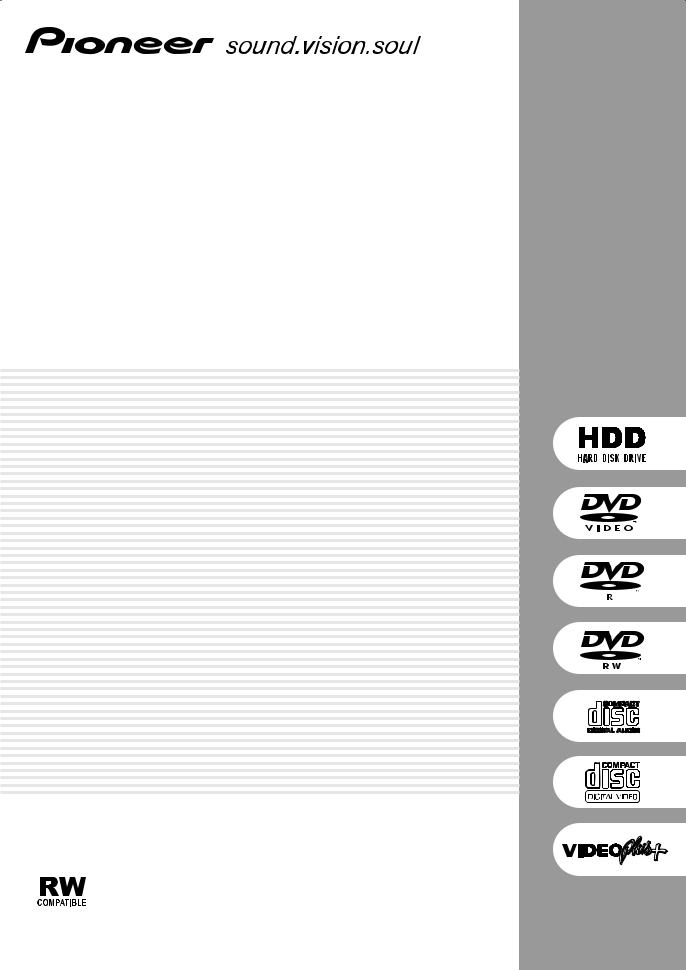
DVD Recorder
DVR-420H
DVR-520H
DVR-720H
®
Operating Instructions
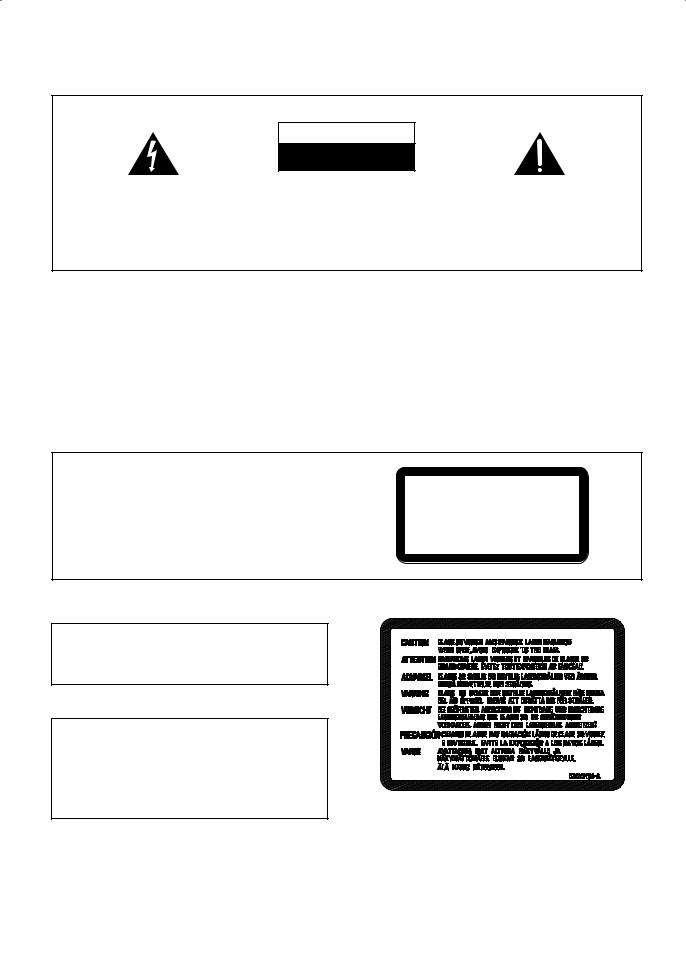
IMPORTANT
CAUTION
RISK OF ELECTRIC SHOCK
DO NOT OPEN
The lightning flash with arrowhead symbol, within an equilateral triangle, is intended to alert the user to the presence of uninsulated "dangerous voltage" within the product's enclosure that may be of sufficient magnitude to constitute a risk of electric shock to persons.
CAUTION:
TO PREVENT THE RISK OF ELECTRIC SHOCK, DO NOT REMOVE COVER (OR BACK). NO USER-SERVICEABLE PARTS INSIDE. REFER SERVICING TO QUALIFIED SERVICE PERSONNEL.
The exclamation point within an equilateral triangle is intended to alert the user to the presence of important operating and maintenance (servicing) instructions in the literature accompanying the appliance.
D3-4-2-1-1_En-A
WARNING: The apparatus is not waterproofs, to prevent fire or shocks hazard, do not expose this apparatus to rain or moisture and do not put any water source near this apparatus, such as vase, flower pot, cosmetics container and medicine bottle etc.
WARNING:
BEFORE PLUGGING IN THE UNIT FOR THE FIRST TIME, READ THE FOLLOWING SECTION CAREFULLY. The voltage of the available power supply differs according to country or region. Be sure that the power supply voltage of the area where this unit will be used meets the required voltage (e.g., 230V or 120V) written on the rear panel.
CAUTION
This product contains a laser diode of higher class than 1. To ensure continued safety, do not remove any covers or attempt to gain access to the inside of the product.
Refer all servicing to qualified personnel.
The following caution label appears on your unit.
LASERCLASS PRODUCT1
D3-4-2-1-8_En
This product complies with the Low Voltage Directive (73/23/EEC, amended by 93/68/EEC), EMC Directives (89/336/EEC, amended by 92/31/EEC and 93/68/EEC).
The STANDBY/ON switch is secondary connected and therefore, does not separate the unit from mains power in STANDBY position. Therefore install the unit suitable places easy to disconnect the MAINS plug in case of the accident. The MAINS plug of unit should be unplugged from the wall socket when left unused for a long period of time.
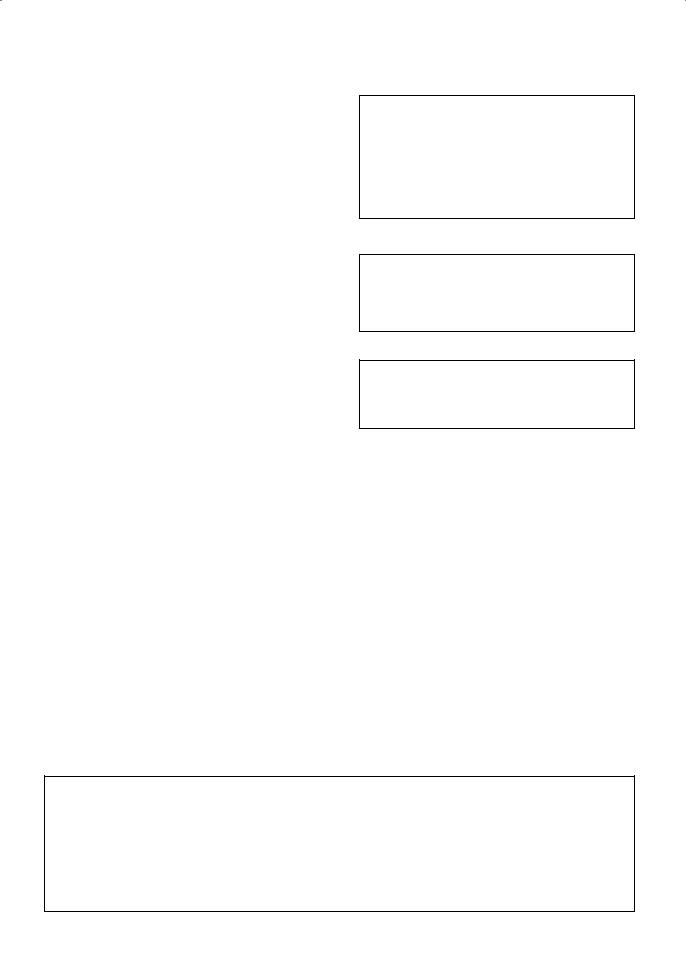
WARNING: No naked flame sources, such as lighted candle, should be placed on the apparatus. If naked flame sources accidentally fall down, fire spread over the apparatus then may cause fire.
D3-4-2-1-7a_En
Operating Environment
Operating environment temperature and humidity: +5 ºC – +35 ºC (+41 ºF – +95 ºF); less than 85 %RH (cooling vents not blocked)
Do not install in the following locations
•Location exposed to direct sunlight or strong artificial light
•Location exposed to high humidity, or poorly
ventilated location
VENTILATION: When installing this unit, make sure to leave space around the unit for ventilation to improve heat radiation (at least 10 cm at top, 10 cm at rear, and 10 cm at each side).
WARNING: Slots and openings in the cabinet are provided for ventilation and to ensure reliable operation of the product and to protect it from overheating, to prevent fire hazard, the openings should never be blocked and covered with items, such as newspapers, table-cloths, curtains, etc. Also do not put the apparatus on the thick carpet, bed, sofa, or fabric having a thick pile.
This product incorporates copyright protection technology that is protected by method claims of certain U.S. patents and other intellectual property rights owned by Macrovision Corporation and other rights owners. Use of this copyright protection technology must be authorized by Macrovision Corporation, and is intended for home and other limited viewing uses only unless otherwise authorized by Macrovision Corporation. Reverse engineering or disassembly is prohibited.
This product is for general household purposes. Any failure due to use for other than household purposes (such as longterm use for business purposes in a restaurant or use in a car or ship) and which requires repair will be charged for even during the warranty period.
This product includes FontAvenue® fonts licenced by NEC
corporation. FontAvenue is a registered trademark of NEC
Corporation.
POWER-CORD CAUTION
Handle the power cord by the plug. Do not pull out the plug by tugging the cord and never touch the power cord when your hands are wet as this could cause a short circuit or electric shock. Do not place the unit, a piece of furniture, etc., on the power cord, or pinch the cord. Never make a knot in the cord or tie it with other cords. The power cords should be routed such that they are not likely to be stepped on. A damaged power cord can cause a fire or give you an electrical shock. Check the power cord once in a while. When you find it damaged, ask your nearest PIONEER authorized service center or your dealer for a replacement.
Replacement and mounting of an AC plug on the power supply cord of this unit should be performed only by qualified service personnel.
IMPORTANT
FOR USE IN THE UNITED KINGDOM
The wires in this mains lead are coloured in accordance with the following code:
Blue : Neutral Brown : Live
If the plug provided is unsuitable for your socket outlets, the plug must be cut off and a suitable plug fitted.
The cut-off plug should be disposed of and must not be inserted into any 13 amp socket as this can result in electric shock. The plug or adaptor or the distribution panel should be provided with 5 A fuse. As the colours of the wires in the mains lead of this appliance may not correspond with coloured markings identifying the terminals in your plug, proceed as follows ;
The wire which is coloured blue must be connected to the terminal which is marked with the letter N or coloured black.
The wire which is coloured brown must be connected to the terminal which is marked with the letter L or coloured red.
Do not connect either wire to the earth terminal of a three pin plug.
NOTE
After replacing or changing a fuse, the fuse cover in the plug must be replaced with a fuse cover which corresponds to the colour of the insert in the base of the plug or the word that is embossed on the base of the plug, and the appliance must not be used without a fuse cover. If lost replacement fuse covers can be obtained from your dealer.
Only 5 A fuses approved by B.S.I or A.S.T.A to B.S.1362 should be used.
D3-4-2-1-2-2_En

Contents
01 Before you start
Features . . . . . . . . . . . . . . . . . . . . . . . . . . . . . . . . . . . 6 What’s in the box . . . . . . . . . . . . . . . . . . . . . . . . . . . . 8
Putting the batteries in the remote control . . . . . . . . . 8
Using the remote control . . . . . . . . . . . . . . . . . . . . . . 8
Disc / content format playback compatibility . . . . . . . 9 About the internal hard disk drive. . . . . . . . . . . . . . . 11
02 Connecting up
Rear panel connections . . . . . . . . . . . . . . . . . . . . . . 12 Front panel connections . . . . . . . . . . . . . . . . . . . . . . 12
Extra features for use with compatible TVs . . . . . . . . 13
Easy connections . . . . . . . . . . . . . . . . . . . . . . . . . . . 14
Using other types of audio/video output . . . . . . . . . . 15 Connecting to a cable box or satellite receiver . . . . . 16 Connecting an external decoder box (1) . . . . . . . . . . 17 Connecting an external decoder box (2) . . . . . . . . . . 18 Connecting to an AV amplifier/receiver . . . . . . . . . . 19 Connecting other AV sources . . . . . . . . . . . . . . . . . . 20
Plugging in. . . . . . . . . . . . . . . . . . . . . . . . . . . . . . . . 20
03 Controls and displays
Front panel . . . . . . . . . . . . . . . . . . . . . . . . . . . . . . . . 21 Display . . . . . . . . . . . . . . . . . . . . . . . . . . . . . . . . . . . 22 Remote control. . . . . . . . . . . . . . . . . . . . . . . . . . . . . 23
04 Getting started
Switching on and setting up . . . . . . . . . . . . . . . . . . . 25 Selecting the hard disk or DVD for playback and recording . . . . . . . . . . . . . . . . . . . . . . . . . . . . . . . . . 28
Making your first recording. . . . . . . . . . . . . . . . . . . . 28 Using the built-in TV tuner . . . . . . . . . . . . . . . . . . . . 29
Basic playback . . . . . . . . . . . . . . . . . . . . . . . . . . . . . 30 Using the Home Menu . . . . . . . . . . . . . . . . . . . . . . . 33
Displaying disc information on-screen . . . . . . . . . . . 33
Switching DVD soundtracks . . . . . . . . . . . . . . . . . . . 43 Switching audio channels . . . . . . . . . . . . . . . . . . . . 44
Switching camera angles . . . . . . . . . . . . . . . . . . . . . 44
06 Recording
About DVD recording . . . . . . . . . . . . . . . . . . . . . . . . 45 About HDD recording. . . . . . . . . . . . . . . . . . . . . . . . 45
Recording time and picture quality. . . . . . . . . . . . . . 46 Restrictions on video recording . . . . . . . . . . . . . . . . 46 Setting the picture quality/recording time . . . . . . . . 47 Basic recording from the TV . . . . . . . . . . . . . . . . . . . 47
Setting a timer recording . . . . . . . . . . . . . . . . . . . . . 49 Timer recording FAQ . . . . . . . . . . . . . . . . . . . . . . . . 55
Simultaneous recording and playback . . . . . . . . . . . 55 Recording from an external component . . . . . . . . . . 56 Automatic recording from a satellite tuner . . . . . . . . 56 Recording from a DV camcorder
(DVR-520H/720H only) . . . . . . . . . . . . . . . . . . . . . . . 57
Recording from the DV output
(DVR-520H/720H only) . . . . . . . . . . . . . . . . . . . . . . . 59
Playing your recordings on other DVD players . . . . . 59 Initializing a DVD-RW disc . . . . . . . . . . . . . . . . . . . . 60
07 Copying and back-up
Introduction . . . . . . . . . . . . . . . . . . . . . . . . . . . . . . . 61
One Touch Copy (HDD to DVD) . . . . . . . . . . . . . . . . 62 One Touch Copy (DVD to HDD) . . . . . . . . . . . . . . . . 62
Copying from HDD to DVD . . . . . . . . . . . . . . . . . . . . 63
HDD to DVD Copy List menu options . . . . . . . . . . . . 64
Recording the Copy List . . . . . . . . . . . . . . . . . . . . . . 65
HDD to DVD Copy List commands . . . . . . . . . . . . . . 65
Copying from DVD to HDD . . . . . . . . . . . . . . . . . . . . 71
DVD to HDD Copy List menu options . . . . . . . . . . . . 72
Recording the Copy List . . . . . . . . . . . . . . . . . . . . . . 72
DVD to HDD Copy List commands . . . . . . . . . . . . . . 73
Using disc back-up . . . . . . . . . . . . . . . . . . . . . . . . . 74
05 Playback
Introduction . . . . . . . . . . . . . . . . . . . . . . . . . . . . . . . 36
Using the Disc Navigator to browse the contents
of a disc.. . . . . . . . . . . . . . . . . . . . . . . . . . . . . . . . . . 36
Navigating discs and the HDD . . . . . . . . . . . . . . . . . 38
Scanning discs. . . . . . . . . . . . . . . . . . . . . . . . . . . . . 38 Playing in slow motion . . . . . . . . . . . . . . . . . . . . . . . 39
Frame advance/frame reverse . . . . . . . . . . . . . . . . . 39
The Play Mode menu . . . . . . . . . . . . . . . . . . . . . . . . 40
Displaying and switching subtitles . . . . . . . . . . . . . . 43
4
08 Editing
The Disc Navigator screen . . . . . . . . . . . . . . . . . . . . 76 Disc Navigator menu options . . . . . . . . . . . . . . . . . . 78 Editing VR mode Original, Video mode and HDD content . . . . . . . . . . . . . . . . . . . . . . . . . . . . . . . . . . . 79 Editing HDD groups . . . . . . . . . . . . . . . . . . . . . . . . . 84
Creating and editing a VR mode Play List . . . . . . . . . 84
En

09 Disc History |
15 Index |
Using the Disc History . . . . . . . . . . . . . . . . . . . . . . . 89
10 The PhotoViewer
Playing a slideshow . . . . . . . . . . . . . . . . . . . . . . . . . 90
11 The Disc Setup menu
Basic settings . . . . . . . . . . . . . . . . . . . . . . . . . . . . . 92 Initialize settings . . . . . . . . . . . . . . . . . . . . . . . . . . . 93 HDD Initialize . . . . . . . . . . . . . . . . . . . . . . . . . . . . . 93 Finalize settings . . . . . . . . . . . . . . . . . . . . . . . . . . . . 93
12 The Video/Audio Adjust menu
Setting the picture quality for TV and external
inputs . . . . . . . . . . . . . . . . . . . . . . . . . . . . . . . . . . . 94
Setting the picture quality for disc playback . . . . . . 95
Audio DRC. . . . . . . . . . . . . . . . . . . . . . . . . . . . . . . . 96
13 The Initial Setup menu
Using the Initial Setup menu . . . . . . . . . . . . . . . . . . 97
Basic settings . . . . . . . . . . . . . . . . . . . . . . . . . . . . . 97 Tuner settings . . . . . . . . . . . . . . . . . . . . . . . . . . . . . 99 Video In / Out settings . . . . . . . . . . . . . . . . . . . . . . 102 Audio In settings . . . . . . . . . . . . . . . . . . . . . . . . . . 103 Audio Out settings. . . . . . . . . . . . . . . . . . . . . . . . . 104 Language settings . . . . . . . . . . . . . . . . . . . . . . . . . 105 Recording settings. . . . . . . . . . . . . . . . . . . . . . . . . 107 Playback settings. . . . . . . . . . . . . . . . . . . . . . . . . . 109
14 Additional information
Resetting the recorder . . . . . . . . . . . . . . . . . . . . . . 112
Setting up the remote to control your TV . . . . . . . . 112 Screen sizes and disc formats . . . . . . . . . . . . . . . . 113
Troubleshooting. . . . . . . . . . . . . . . . . . . . . . . . . . . 114
Frequently asked questions . . . . . . . . . . . . . . . . . . 116 About DV (DVR-520H/720H only) . . . . . . . . . . . . . . 117
Manual recording modes. . . . . . . . . . . . . . . . . . . . 118 Language code list. . . . . . . . . . . . . . . . . . . . . . . . . 119 Country code list . . . . . . . . . . . . . . . . . . . . . . . . . . 119
On-screen displays and recorder displays . . . . . . . 120
Handling discs. . . . . . . . . . . . . . . . . . . . . . . . . . . . 121 Storing discs . . . . . . . . . . . . . . . . . . . . . . . . . . . . . 121 Damaged discs . . . . . . . . . . . . . . . . . . . . . . . . . . . 121 Cleaning the pickup lens . . . . . . . . . . . . . . . . . . . . 122 Condensation . . . . . . . . . . . . . . . . . . . . . . . . . . . . 122 Hints on installation. . . . . . . . . . . . . . . . . . . . . . . . 122 Moving the recorder. . . . . . . . . . . . . . . . . . . . . . . . 122 Glossary. . . . . . . . . . . . . . . . . . . . . . . . . . . . . . . . . 122 Specifications . . . . . . . . . . . . . . . . . . . . . . . . . . . . 125
5
En
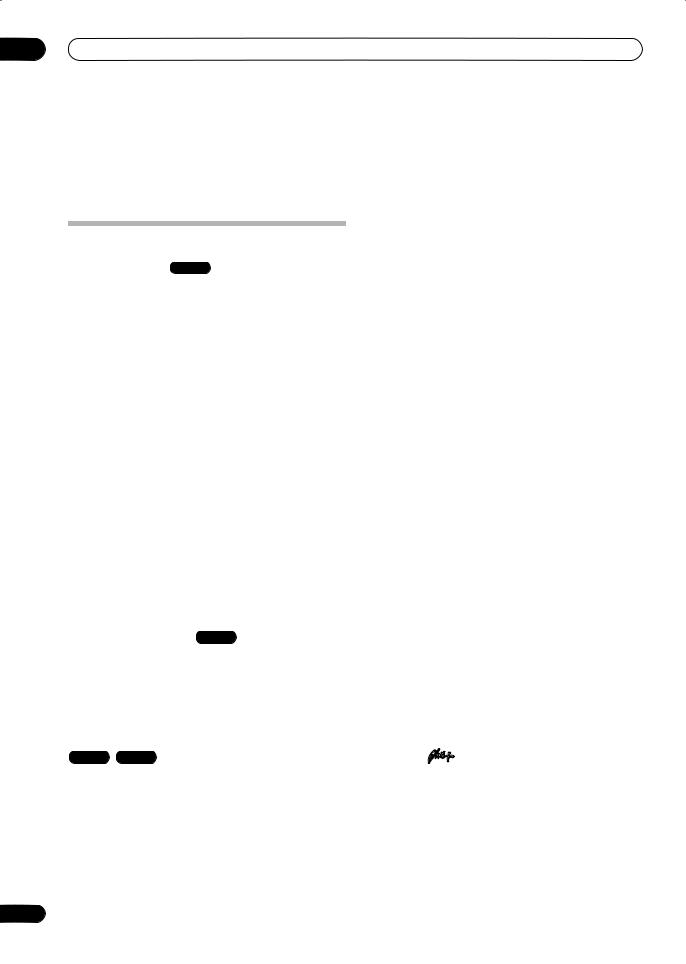
01 Before you start
Chapter 1
Before you start
Features
• HDD recording HDD
You can record up to 102 hours of video (in EP mode) on the internal 80GB (gigabyte) hard disk (HDD) on the DVR420H/520H, or up to 204 hours on the 160GB DVR-720H.
With both recordable DVD and a high-capacity HDD in the same recorder, you have the flexibility to keep recordings on the HDD for quick access anytime, or record to DVD for archiving or playing on other DVD players.
•Copy between HDD and DVD
You can copy recordings from the HDD to recordable DVD, or from DVD to the HDD. Usually you can use the high-speed copy feature, which can copy an hour of video in under two minutes (when recorded in EP mode using a DVD-R Ver. 2.0 / 8x disc).
You can also choose to copy material at a different recording quality from the original. For example, you might want to copy a FINE mode (highest quality) recording on the HDD to SP (standard play) quality on a DVD so that you can fit other recordings on the same disc.
•One Touch Copy
One Touch Copy makes copying the currently playing title from HDD to DVD, or DVD to HDD as simple as pressing a button.
• Chase play  HDD
HDD
Using chase play you can start watching a recording before the recording has finished. For example, you could set a timer recording for a program that you’re going to miss the first 15 minutes of, then start watching while the recorder is still recording the program 15 minutes ahead of you.
•Simultaneous recording and playback
VR mode |
HDD |
Playback and recording for both DVDs and the built-in hard disk drive (HDD) are completely independent. For example you can record a broadcast program to either a recordable DVD or the HDD, while watching another recording you already made on the same DVD or on the HDD.
6
•Disc Navigator
The on-screen Disc Navigator makes finding your way around the contents of a disc or the HDD easy. For recordable DVD and HDD content, moving thumbnail images are displayed for ease of use. The Disc Navigator is also where you can edit HDD and recordable DVD content.
•Disc History
The Disc History screen shows disc information, including how much free space remains for recording, for the last 30 recordable discs loaded in the recorder. Every time you load a recordable disc, the Disc History is automatically updated with the latest information.
•Home Menu
The Home Menu gives you on-screen access to all the recorder’s features in one convenient place, from setting up the recorder, to programming a timer recording and editing a recording.
•Cinema surround sound in your home
Connect this recorder to a Dolby Digital and/or DTScompatible AV amp/receiver to enjoy full surround sound effects from Dolby Digital and DTS DVD discs.
•Easy Timer Recording
Setting the recorder to record a program is simple from the Easy Timer Recording screen. Set the channel to record and the recording quality, then graphically set the start and end times of the recording. That’s it!
•Program up to 32 timer recordings
You can program the recorder to record up to 32 programs, up to a month in advance, using the
VIDEO Plus+® system* for easy programming if you want. As well as single programs, you can specify daily or weekly recordings, too.
This recorder is also compatible with VPS/PDC systems, which ensure you don’t miss a timer recording, even if the broadcast is not running to schedule.
*1 





 ® is a registered trademark of Gemstar Development Corporation.
® is a registered trademark of Gemstar Development Corporation.
The VIDEO Plus+ system is manufactured under license from Gemstar Development Corporation.
•One Touch Recording
Use One Touch Recording to start recording immediately in 30 minute blocks. Each time you press the REC button, the recording time is extended by another 30 minutes.
En
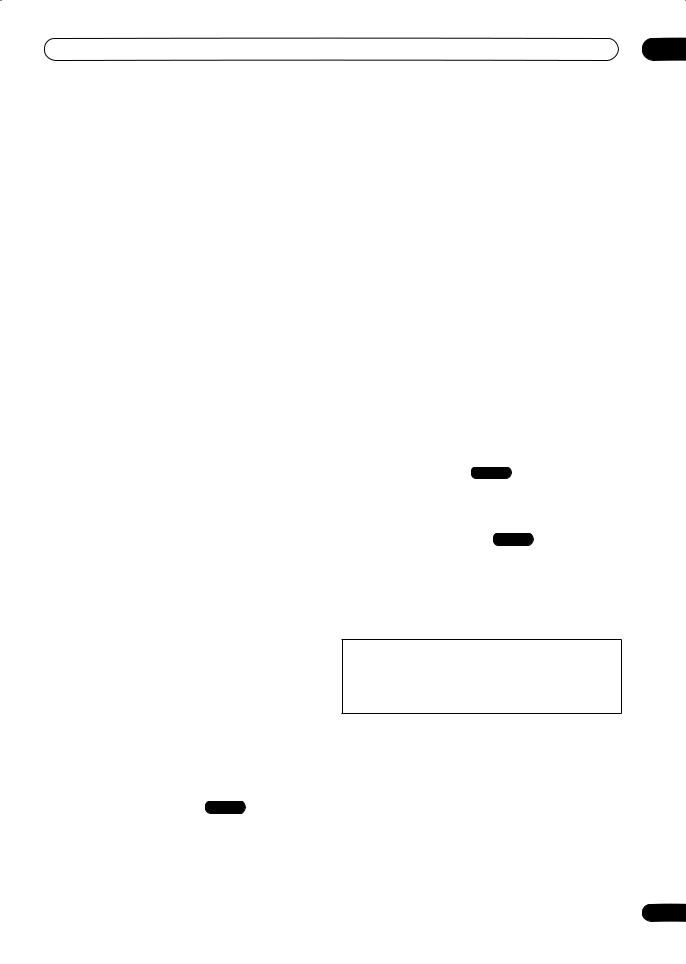
Before you start |
01 |
•Optimized recording
Optimized recording adjusts the recording quality automatically if a timer recording will not fit onto a disc with the settings that you made.
•Auto Start Recording from satellite receiver or other set top box
With a satellite receiver or other set top box connected to the AV2/AUTO START REC (INPUT 1/DECODER) inputs of this recorder, you can start and stop recording automatically according to the timer settings of the set top box.
•High quality 16-bit Linear PCM audio
When recording using one of the high quality record settings (FINE or MN32), the audio is recorded in uncompressed 16-bit Linear PCM format. This delivers great sounding audio to accompany the high picture quality.
•Picture quality adjustment features
During playback, you can adjust various picture quality settings to improve the picture. You can also adjust the recording picture quality. For example, if you want to make a DVD copy of an old video tape, you can optimize the picture quality before transferring it to disc.
•Find what you want to watch quickly and easily
Unlike video tape that needs to be wound to the correct place, you can jump right to the part of a DVD disc or the HDD that you want to watch. Search for a point on a disc by title, chapter or time.
•Manual recording
In addition to the four preset recording quality modes (FINE, SP, LP and EP), the manual recording mode allows you to access 32 different recording quality/time settings, giving you precise control over the recording.
• Record to and from a DV camcorder (DVR-520H/ 720H only)
This recorder has a built-in DV (Digital Video) input/ output jack for connection to a DV camcorder. This makes it ideal for transferring camcorder footage to DVD or HDD for editing. You can also transfer DVD or HDD content back to the camcorder if you need to.
• Safe, non-destructive editing 
When you edit a DVD-RW, the actual content of the disc (the Original content) is not touched. The edited version (the Play List content) just points to various parts of the Original content.
• Chapter marking  HDD
HDD
You can easily add chapter markers anywhere in your recordings for easy editing.
•Play Video mode recordings on a regular DVD
player 
Discs recorded using the Video mode can be played back on regular DVD players, including computer DVD drives
compatible with DVD-Video playback*.
* ‘DVD-Video format’ recording: The use of the DVDVideo format for recording on DVD-R and DVD-RW discs is referred to as recording in ‘Video mode’ on Pioneer’s DVD recorders. Supporting playback of DVD-R / DVDRW discs is optional for manufacturers of DVD playback equipment, and there is DVD playback equipment that does not play DVD-R or DVD-RW discs recorded in the DVD-Video format.
Note: ‘Finalization’ is required.
•WMA, MP3 and JPEG file playback
This recorder can play WMA and MP3 audio files and JPEG picture files on CD-R, CD-RW or CD-ROM discs.
•Disc Back-up
The disc back-up feature gives you a convenient way to back-up important material on DVD to another recordable DVD disc. The material is first copied to the HDD, then on to a second DVD disc.
• Recovery Recording HDD
When a timer recording is set to use DVD but the disc loaded at the time of the recording is unrecordable, the program will automatically be recorded to the HDD.
• Auto Replace Recording HDD
This feature is useful for regular timer recordings of a TV program which you don’t want to keep after watching. Each time the program is recorded, it replaces the one currently on the HDD. There’s no need to manually delete it later.
Note on copying:
Recording equipment should be used only for lawful copying and you are advised to check carefully what is lawful copying in the country in which you are making a copy. Copying of copyright material such as films or music is unlawful unless permitted by a legal exception or consented to by the rightowners.
7
En
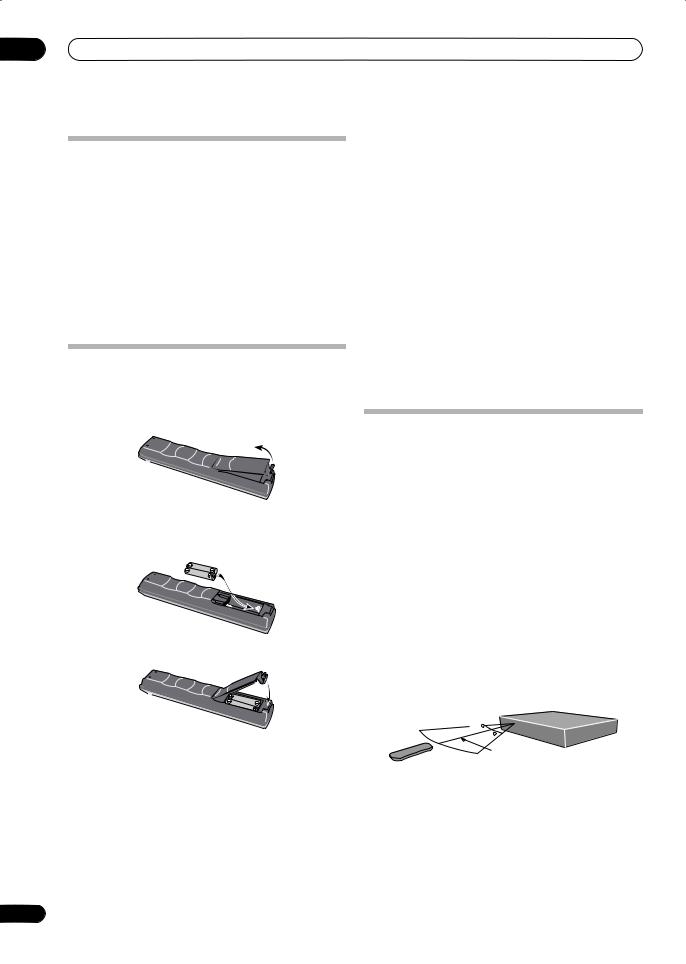
01 Before you start
What’s in the box
Please confirm that the following accessories are in the box when you open it.
•Remote control
•AA/R6P dry cell batteries x2
•Audio/video cable (red/white/yellow)
•RF antenna cable
•Power cable
•These operating instructions
•Warranty card
Putting the batteries in the remote control
1 Open the battery compartment cover on the back of the remote control.
2 Insert two AA/R6P batteries into the battery compartment following the indications ( , ) inside the compartment.
3 Close the cover.
8
 Note
Note
Incorrect use of batteries can result in hazards such as leakage and bursting. Please observe the following:
•Don’t mix new and old batteries together.
•Don’t use different kinds of batteries together— although they may look similar, different batteries may have different voltages.
•Make sure that the plus and minus ends of each battery match the indications in the battery compartment.
•Remove batteries from equipment that isn’t going to be used for a month or more.
•When disposing of used batteries, please comply with governmental regulations or environmental public instruction’s rules that apply in your country or area.
Using the remote control
Please keep in mind the following when using the remote control:
•Make sure that there are no obstacles between the remote and the remote sensor on the unit.
•Remote operation may become unreliable if strong sunlight or fluorescent light is shining on the unit’s remote sensor.
•Remote controllers for different devices can interfere with each other. Avoid using remotes for other equipment located close to this unit.
•Replace the batteries when you notice a fall off in the operating range of the remote.
•When the batteries run down or you change the batteries, the remote control mode and TV preset codes are automatically reset. See Remote Control Set on page 99 and Setting up the remote to control your TV on page 112 to reset them.
•Use within the operating range and angle, as shown.
30
30
7m
•You can control this recorder using the remote sensor of another Pioneer component using the CONTROL IN jack on the rear panel. See Rear panel connections on page 12 for more information.
En

Before you start |
01 |
Disc / content format playback compatibility
General disc compatibility
This recorder is compatible with a wide range of disc types (media) and formats. Playable discs will generally feature one of the following logos on the disc and/or disc packaging. Note however that some disc types, such as recordable CD and DVD, may be in an unplayable format—see below for further compatibility information.
DVD-Video DVD-R DVD-RW
Note that older models of DVD recorders and DVD writers may reject DVD-RW Ver. 1.2 / 4x discs. If you want to share DVD-RW discs between this recorder and an older recorder/writer, we recommend using Ver. 1.1 discs.
The following table shows older Pioneer DVD recorder compatibility with DVD-RW Ver. 1.2 / 4x discs.
Model |
Playable |
Recordable |
DVR-7000 |
Yes1,2,3 |
No |
DVR-3100/ DVR-5100H |
Yes1 |
No |
1Discs should be finalized in this recorder before playing. Unfinalized VR mode and Video mode discs may not play.
2Cannot read the CPRM information will show in the display when you load a disc. However, this will not affect playback.
3Copy-once protected disc titles will not play.
Audio CD |
Video CD |
CD-R |
CD-RW |
Fujicolor CD
•Also compatible with KODAK Picture CD
• is a trademark of DVD Format/Logo Licensing Corporation.
is a trademark of DVD Format/Logo Licensing Corporation.
• is a trademark of Fuji Photo Film Co. Ltd.
is a trademark of Fuji Photo Film Co. Ltd.
This recorder also supports the IEC’s Super VCD standard. Compared to the Video CD standard, Super VCD offers superior picture quality, and allows two soundtracks to be recorded. Super VCD also supports the widescreen size.
VIDEO

 CD
CD
Super Video CD (Super VCD)
DVD-R/RW compatibility
This recorder will play and record DVD-R/RW discs.
Compatible media:
•DVD-RW Ver. 1.1, Ver. 1.1 / 2x and Ver. 1.2 / 4x
•DVD-R Ver. 2.0 and Ver. 2.0 / 4x / 8x Recording formats:
•DVD-R: DVD-Video format (Video mode)
•DVD-RW: Video Recording (VR) format and DVDVideo format (Video mode)
CD-R/RW compatibility
This recorder cannot record CD-R or CD-RW discs.
•Compatible formats: CD-Audio, Video CD/Super VCD, ISO 9660 CD-ROM* containing MP3, WMA or JPEG files
*ISO 9660 Level 1 or 2 compliant. CD physical format: Mode1, Mode2 XA Form1. Romeo and Joliet file systems are both compatible with this recorder.
•Multi-session playback: Yes (except CD-Audio and Video CD/Super VCD)
•Unfinalized disc playback: CD-Audio only
Compressed audio compatibility
•Compatible media: CD-ROM, CD-R, CD-RW
•Compatible formats: MPEG-1 Audio Layer 3 (MP3), Windows Media Audio (WMA)
•Sampling rates: 44.1 or 48kHz
•Bit-rates: Any (128Kbps or higher recommended)
•Variable bit-rate (VBR) MP3 playback: Yes
•VBR WMA playback: No
•WMA encoder compatibility: Windows Media Codec 8 (files encoded using Windows Media Codec 9 may be playable but some parts of the specification are not supported; specifically, Pro, Lossless, Voice and VBR)
•DRM (Digital Rights Management) file playback: No (see also DRM in the Glossary on page 122)
•File extensions: .mp3, .wma (these must be used for the recorder to recognize MP3 and WMA files – do not use for other file types)
•File structure: Up to 99 folders / 999 files (if these limits are exceeded, only files and folders up to these limits are playable)
9
En
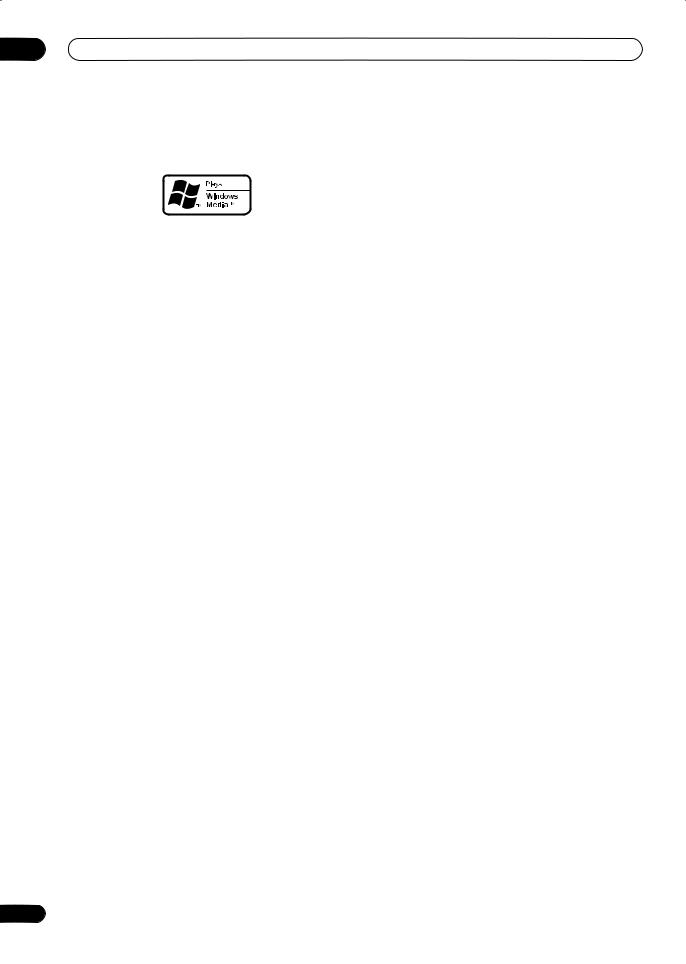
01 Before you start
WMA (Windows Media Audio) compatibility
The Windows Media® logo printed on the box indicates that this recorder can playback Windows Media Audio content.
WMA is an acronym for Windows Media Audio and refers to an audio compression technology developed by Microsoft Corporation. WMA content can be encoded by
using Windows Media® Player version 7, 7.1, Windows
Media® Player for Windows® XP, or Windows Media® Player 9 Series.
Microsoft, Windows Media, and the Windows logo are trademarks, or registered trademarks of Microsoft Corporation in the United States and/or other countries.
JPEG file compatibility
•Compatible formats: Baseline JPEG and EXIF 2.2* still image files
*File format used by digital still cameras
•Sampling ratio: 4:4:4, 4:4:2, 4:2:0
•Horizontal resolution: 160 – 5120 pixels
•Vertical resolution: 120 – 3840 pixels
•Progressive JPEG compatible: No
•File extensions: .jpg, jpeg, jif, jfif (must be used for the recorder to recognize JPEG files – do not use for other file types)
•File structure: The recorder can load up to 99 folders / 999 files at one time (if there are more files/folders that this on the disc then more can be reloaded)
PC-created disc compatibility
Discs recorded using a personal computer may not be playable in this unit due to the setting of the application software used to create the disc. In these particular instances, check with the software publisher for more detailed information.
Discs recorded in packet write mode (UDF format) are not compatible with this recorder.
Check the DVD-R/RW or CD-R/RW software disc boxes for additional compatibility information.
 Frequently asked questions
Frequently asked questions
•What’s the difference between DVD-R and DVD-RW?
The most important difference between DVD-R and DVD-RW is that DVD-R is a record-once medium, while DVD-RW is a re-recordable/erasable medium. You can re-record/erase a DVD-RW disc approximately 1,000 times.
For more information, see About DVD recording on page 45.
•What’s VR mode?
VR (Video Recording) mode is a special mode designed for home DVD recording. It allows flexible editing of recorded material compared to ‘Video mode’. On the other hand, Video mode discs are more compatible with other DVD players.
•Can I play my recordable discs in a regular DVD player?
Generally, DVD-R discs and DVD-RW discs recorded in Video mode* are playable in a regular DVD player, but they must be ‘finalized’ first. This process fixes the contents of the disc to make them readable to other DVD players as DVD-Video discs.
DVD-RW discs recorded in VR mode are playable in some players.


 This label indicates playback compatibility with DVD-RW discs recorded in VR mode (Video Recording format). However, for discs recorded with a record-only-once encrypted program, playback can only be achieved using the CPRM compatible device.
This label indicates playback compatibility with DVD-RW discs recorded in VR mode (Video Recording format). However, for discs recorded with a record-only-once encrypted program, playback can only be achieved using the CPRM compatible device.
Note that Pioneer cannot guarantee that discs recorded using this recorder will play on other players.
*‘DVD-Video format’ recording: The use of the DVDVideo format for recording on DVD-R and DVD-RW discs is referred to as recording in ‘Video mode’ on Pioneer’s DVD recorders. Supporting playback of DVD-R / DVDRW discs is optional for manufacturers of DVD playback equipment, and there is DVD playback equipment that does not play DVD-R or DVD-RW discs recorded in the DVD-Video format.
Note: ‘Finalization’ is required.
This recorder supports the recording of ‘copy-once’ broadcast programs using the CPRM copy protection system (see CPRM on page 46) on CPRM-compliant DVD-RW discs in VR mode. CPRM recordings can only be played on players that are specifically compatible with CPRM.
10
En
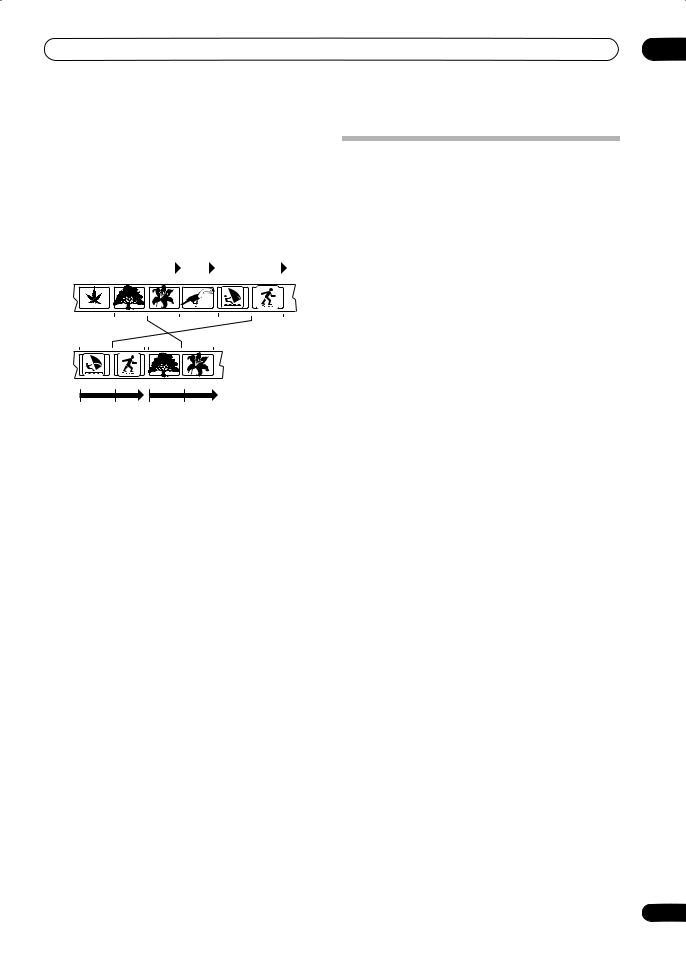
Before you start
•Do I need two DVD recorders for editing? What kind of editing can I do?
Unlike editing video tape, you only need one DVD recorder to edit discs. With DVD, you edit by making a ‘Play List’ of what to play and when to play it. On playback, the recorder plays the disc according to the Play List.
Original
Title 1 |
|
|
|
|
|
|
Title 2 |
|
Title 3 |
|
|
|
|||
|
|
|
|
|
|
|
|
|
|
|
|
|
|
|
|
|
|
|
|
|
|
|
|
|
|
|
|
|
|
|
|
Chapter 1 |
Chapter 2 |
Chapter 3 |
|
|
Chapter 1 |
|
|
Chapter 1 |
Chapter 2 |
|
|||||
|
|
|
|
|
|
|
|
|
|
|
|
|
|
|
|
|
|
|
|
|
|
|
|
|
|
|
|
|
|
|
|
Title 1 |
|
Title 2 |
|
Chapter 1 |
Chapter 2 |
Chapter 1 |
Chapter 2 |
Play List
Throughout this manual, you will often see the words Original and Play List to refer to the actual content and the edited version.
•Original content refers to what’s actually recorded on the disc.
•Play List content refers to the edited version of the disc—how the Original content is to be played.
01
About the internal hard disk drive
The internal hard disk drive (HDD) is a fragile piece of equipment. Please use the recorder following the guidelines below to protect against possible HDD failure.
We recommend that you back up your important recordings onto DVD-R/RW discs in order to protect against accidental loss.
•Do not move the recorder while it is on.
•Install and use the recorder on a stable, level surface.
•Do not block the rear vent/cooling fan.
•Do not use the recorder in excessively hot or humid places, or in places that may be subject to sudden changes in temperature. Sudden changes in temperature can cause condensation to form inside the recorder. This can be a cause of HDD failure.
•While the recorder is switched on, do not unplug from the wall socket or switch the electricity off from the breaker switch.
•Do not move the recorder immediately after switching it off. If you need to move the recorder, please follow the steps below:
1 After the message POWER OFF is shown in the display, wait at least two minutes.
2 Unplug from the wall socket.
3 Move the recorder.
•If there’s a power failure while the recorder is on there is a chance that some data on the HDD will be lost.
•The HDD is very delicate. If used improperly or in an unsuitable environment, it is possible that the HDD will fail after a few years of use. Signs of problems include playback unexpectedly freezing and noticeable block noise (mosaic) in the picture. However, sometimes there will be no warning signs of HDD failure.
If the HDD fails, no playback of recorded material will be possible. In this case it will be necessary to replace the HDD unit.
11
En
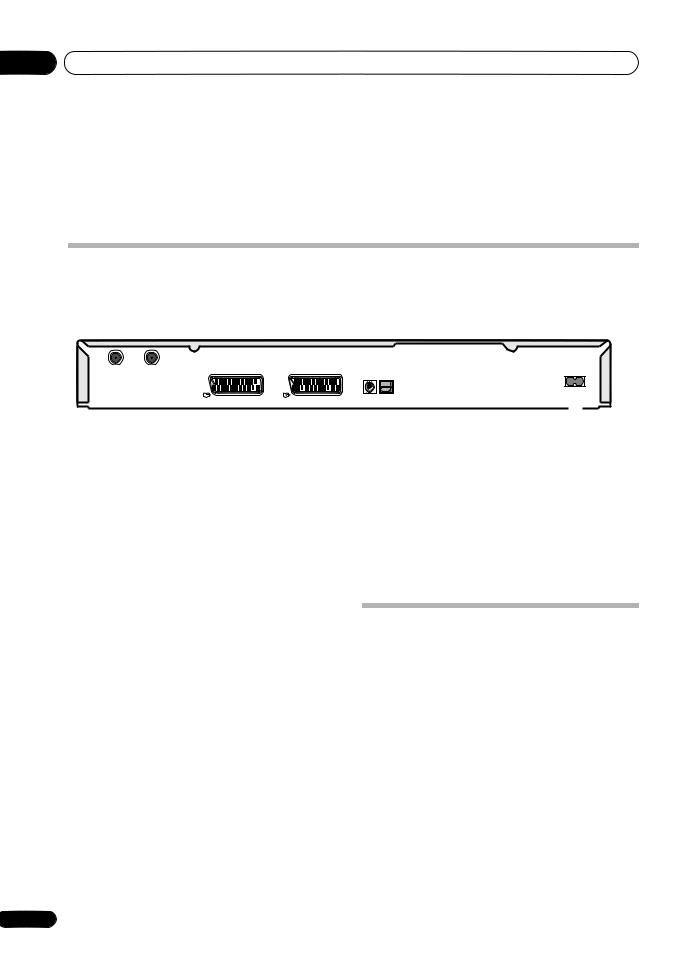
02 Connecting up
Chapter 2
Connecting up
Rear panel connections
1 |
2 |
3 |
4 |
5 |
6 |
7 |
ANTENNA
OUT |
IN |
|
|
|
|
AC IN |
R |
L |
|
|
|
|
|
AUDIO |
VIDEO |
S-VIDEO |
AV 1 (RGB) - TV |
AV 2/AUTO START REC |
IN |
OPTICAL |
|
||||||
|
OUTPUT |
CONTROL |
DIGITAL OUT |
|||
|
|
|
(INPUT 1/DECODER) |
1 ANTENNA IN/OUT
Connect your TV antenna to the ANTENNA IN jack. The signal is passed through to the ANTENNA OUT jack for connection to your TV.
2 OUTPUT jacks
Stereo analog audio, video and S-video outputs for connection to a TV or AV amplifier/receiver.
3 AV1(RGB)-TV AV connector
Audio/video output SCART-type AV connector for connecting to a TV or other equipment with a SCART connector. The video output is switchable between video, S-video and RGB. See page AV1 Out on page 102 for how to set this up.
4AV2/AUTO START REC (INPUT 1/DECODER) AV connector
Audio/video input/output SCART-type AV connector for connecting to a VCR, or other equipment with a SCART connector. The input accepts video, S-video and RGB.
See AV2/L1 In on page 102 for how to set this up.
5CONTROL IN
Use to control this recorder from the remote sensor of another Pioneer component with a CONTROL OUT terminal and bearing the Pioneer mark. Connect the CONTROL OUT of the other component to the CONTROL IN of this recorder using a mini-plug cord.
6 DIGITAL OUT OPTICAL
For connecting to an AV amplifier/receiver, Dolby Digital/ DTS/MPEG decoder or other equipment with optical digital input.
7 AC IN – Power inlet
Front panel connections
DV IN/OUT
S-VIDEO VIDEO
On the left side of the front panel a flip-down cover hides a second audio/video input, consisting of an S-video and standard (composite) video jack, and stereo analog audio jacks.
DV-520H/720H only: On the right side is the DV input/ output i.LINK connector. This is for connection to a DV camcorder.
12
En

Connecting up |
02 |
Extra features for use with compatible TVs
When this recorder is connected to a TV that features T-V Link, EasyLink, MegaLogic, SMARTLINK, Q-Link, DATA LOGIC or NexTView Link using a fully-wired 21-pin SCART cable (not supplied), the following functions are available:
•Direct TV recording
•Channel preset download
•Electronic Program Guide (EPG) download
•TV auto power on
•System configuration
EPG download
EPG download allows you to program a timer recording directly from the electronic program guide displayed on your TV.
See the manual that came with your TV for more information on how to use this feature. Note that the SP and LP options displayed on your TV correspond to the SP and LP recording modes on this recorder.
TV auto power on
When you play a disc in this recorder, the TV automatically turns on and switches to the correct video input. See the manual that came with your TV for how to use this feature.
Direct TV recording
Direct TV recording allows you to record the TV program that you’re watching, without having to worry about whether this recorder is set to the same channel. See
Direct recording from TV on page 48 for more on this feature.
Channel preset download
This feature allows you to set up the channel presets of this recorder very simply using the channel presets and preset names already in your TV. See Switching on and setting up on page 25 and Auto Channel Setting :
Download from TV on page 100 for more on this feature.
System configuration
Basic settings, including language, country and TV screen size (aspect ratio), can be downloaded from your TV to help set up this recorder for use.
 Note
Note
•For further details and compatibility information, see also the manual that came with your TV.
13
En
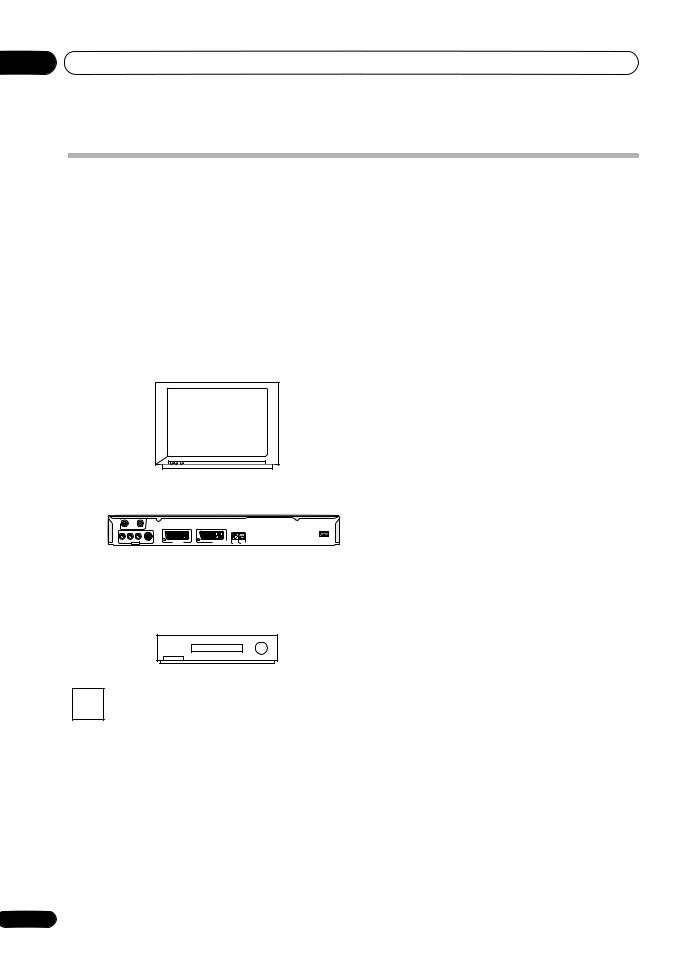
02 Connecting up
Easy connections
The setup described below is a basic setup that allows you to watch and record TV programs, and play discs. Other types of connections are explained starting on the following page.
 Important
Important
•These connections use SCART cables (not supplied). If your TV (or VCR) does not have a SCART connection, see the following page for connecting up using the supplied audio/video cable.
•The AV1(RGB)-TV AV connector can output ordinary (composite), S-video or RGB video, plus stereo analog audio. The AV2/AUTO START REC (INPUT 1/DECODER) connector accepts ordinary, S-video and RGB video input, as well as stereo analog audio. See AV1 Out on page 102 and AV2/L1 In on page 102 for how to set them up.
•Before making or changing any rear panel connections, make sure that all components are switched off and unplugged from the wall outlet.
|
ANTENNA |
|
|
IN |
|
|
|
SCART AV |
|
|
CONNECTOR |
3 |
4 |
TV |
ANTENNA
OUT |
IN |
|
|
|
|
AC IN |
R |
L |
|
|
|
|
|
AUDIO |
VIDEO |
S-VIDEO |
AV 1 (RGB) - TV |
AV 2/AUTO START REC |
IN |
OPTICAL |
|
OUTPUT |
|
|
(INPUT 1/DECODER) |
CONTROL |
DIGITAL OUT |
5
2
SCART AV
ANTENNA CONNECTOR
OUT
VCR
ANTENNA
IN
 1
1
Antenna/cable TV wall outlet
1Connect the cable from the antenna/cable TV outlet to the antenna input on your VCR.
•If you are not connecting a VCR in the chain, connect it to the ANTENNA IN jack on this recorder and skip the next step.
2Use an RF antenna cable (one is supplied) to connect the antenna output of your VCR to the ANTENNA IN of this recorder.
3Use another RF antenna cable to connect the ANTENNA OUT of this recorder to the antenna input on your TV.
4Use a SCART cable (not supplied) to connect the AV1(RGB)-TV AV connector on this recorder to the SCART AV connector on your TV.
5Use another SCART cable to connect the AV2/ AUTO START REC (INPUT 1/DECODER) AV connector to a SCART AV connector on your VCR.
 Note
Note
•See the following page if you want to use one of the other kinds of audio/video connection.
 Tip
Tip
•This recorder has a ‘through’ function which allows you to record a TV program from the built-in TV tuner in this recorder while watching a video playing on your VCR. (To use this feature when the recorder is in standby, Power Save must be set to Off—see Power Save on page 98).
14
En
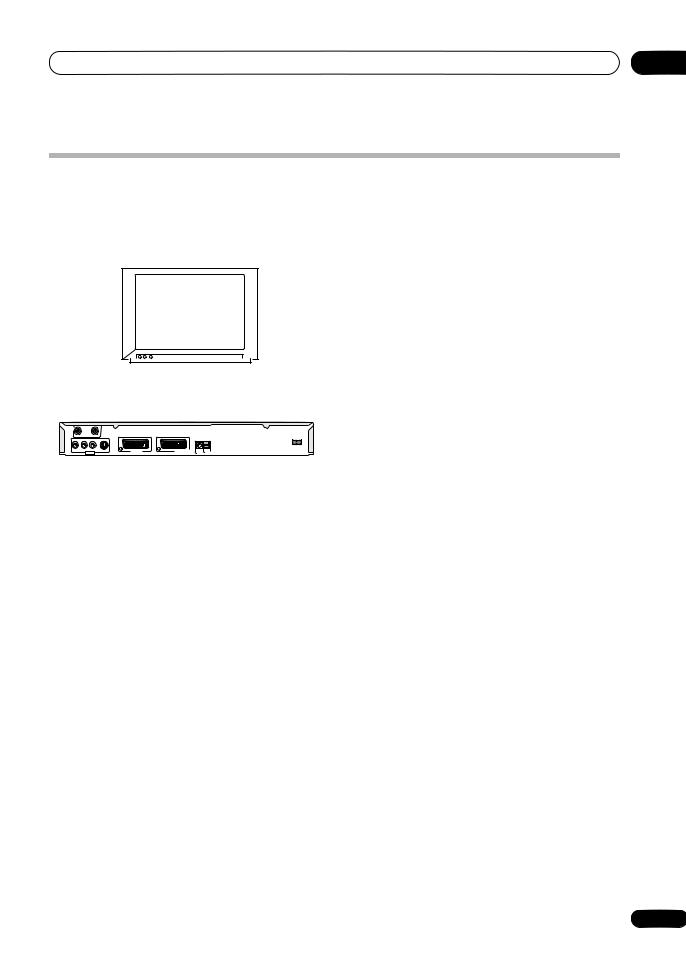
Connecting up |
02 |
Using other types of audio/video output
If you can’t use the SCART AV connector to connect your TV to this recorder, there are standard audio/video output jacks, as well as an S-video output.
Using the supplied audio/video cable |
Using the S-video output |
|
AUDIO |
|
|
|
|
|
|
|
|
|
|
|
|
INPUT |
|
|
|
|
|
|
|
|
|
|
|
|
|
|
|
|
|
AUDIO |
|
|
|
|
S-VIDEO |
|
|
|
|
|
|
|
INPUT |
|
|
|
|
||
|
VIDEO |
|
|
|
|
|
|
|
|
INPUT |
||
|
|
|
|
|
|
|
|
|
|
|
||
|
|
|
|
|
|
|
|
|
|
|
|
|
|
INPUT |
|
|
|
2 |
|
|
|
|
|
|
1 |
|
|
TV |
|
|
|
|
|
TV |
|
|
||
|
|
|
|
|
|
|
|
|
|
|
||
2 |
1 |
|
|
|
|
|
|
|
|
|
|
|
ANTENNA |
|
|
|
|
|
|
|
|
|
|
|
|
|
|
|
|
|
ANTENNA |
|
|
|
|
|
|
|
OUT |
IN |
|
|
|
AC IN |
|
|
|
|
|
|
AC IN |
R |
L |
|
|
|
|
OUT |
IN |
|
|
|
|
|
|
|
|
|
|
R |
|
L |
|
|
|
|
|
AUDIO |
VIDEO S-VIDEO |
AV 1 (RGB) - TV |
AV 2/AUTO START REC |
IN |
OPTICAL |
|
|
|
|
|
|
|
|
OUTPUT |
|
(INPUT 1/DECODER) |
CONTROL DIGITAL OUT |
AUDIO |
VIDEO |
S-VIDEO |
AV 1 (RGB) - TV |
AV 2/AUTO START REC |
IN |
OPTICAL |
|
|
|
|
|
|
|
|
OUTPUT |
|
|
(INPUT 1/DECODER) |
CONTROL DIGITAL OUT |
|
1Connect the VIDEO OUTPUT jack to a video input on your TV.
Use the yellow jack of the supplied audio/video cable for the video connection.
2Connect the AUDIO OUTPUT jacks to the corresponding audio inputs on your TV.
Use the red and white jacks of the supplied audio/video cable for the audio connection. Make sure you match up the left and right outputs with their corresponding inputs for correct stereo sound.
1Use an S-video cable (not supplied) to connect the S-VIDEO OUTPUT to an S-video input on your TV, monitor (or other equipment).
2Connect the AUDIO OUTPUT jacks to the corresponding audio inputs on your TV.
You can use the supplied audio/video cable, leaving the yellow video plug disconnected. Make sure you match up the left and right outputs with their corresponding inputs for correct stereo sound.
15
En
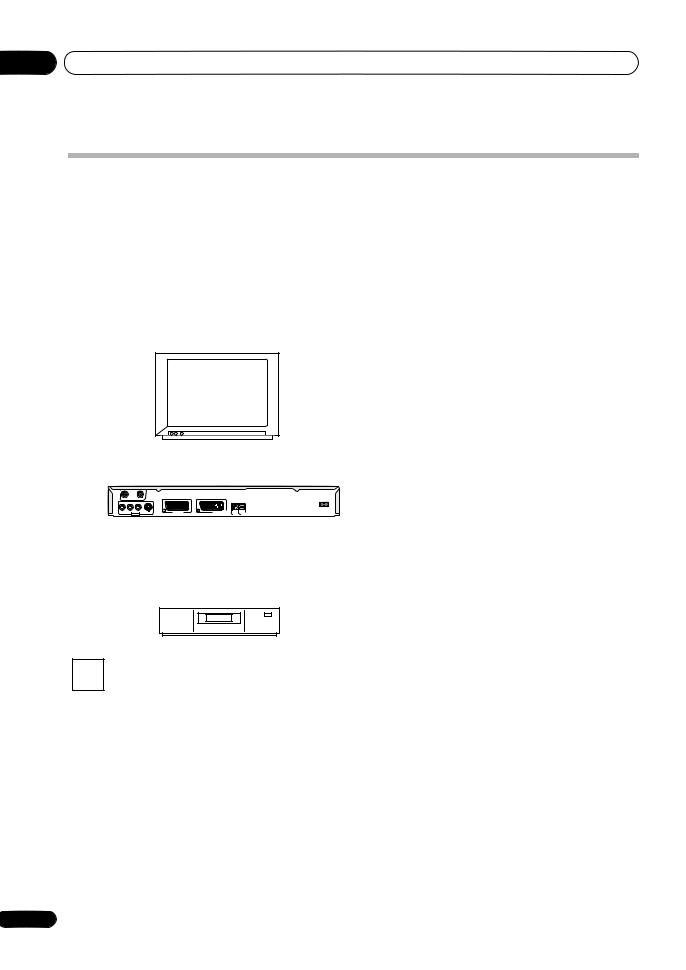
02 Connecting up
Connecting to a cable box or satellite receiver
If you have a cable or satellite receiver with a built-in decoder, connect it to this recorder and your TV as shown on this page. If you are using a separate decoder box for your cable/satellite TV, set up following the instructions on the next page.
Using the setup on this page you can:
• Record any channel by selecting it on the cable box/satellite tuner.
 Important
Important
•Do not connect this recorder ‘through’ your VCR, satellite receiver or cable box. Always connect each component directly to your TV or AV amplifier/receiver.
1 Connect RF antenna cables as shown.
|
ANTENNA |
|
|
IN |
|
|
|
SCART AV |
|
|
CONNECTOR |
1 |
2 |
TV |
This enables you to watch and record TV channels.
2Use a SCART cable (not supplied) to connect the AV1(RGB)-TV AV connector to a SCART AV connector on your TV.
This enables you to watch discs.
3Use another SCART cable to connect the AV2/ AUTO START REC (INPUT 1/DECODER) AV connector to a SCART AV connector on your satellite/cable box.
This enables you to record scrambled TV channels.
ANTENNA
OUT |
IN |
AC IN |
R |
L |
|
AUDIO |
VIDEO |
S-VIDEO |
AV 1 (RGB) - TV |
AV 2/AUTO START REC |
IN |
OPTICAL |
|
OUTPUT |
|
|
(INPUT 1/DECODER) |
CONTROL |
DIGITAL OUT |
3
1
SCART AV
ANTENNA CONNECTOR
OUT
Cable/Satellite box
ANTENNA
IN
 1
1
Antenna/cable TV wall outlet
 Note
Note
•The diagram shows SCART video connections, but you can alternatively use any of the other audio/video connections.
 Tip
Tip
•This recorder has a ‘through’ function which allows you to record a TV program from the built-in TV tuner in this recorder while watching a video playing on your VCR. (To use this feature when the recorder is in standby, Power Save must be set to Off—see Power Save on page 98).
16
En
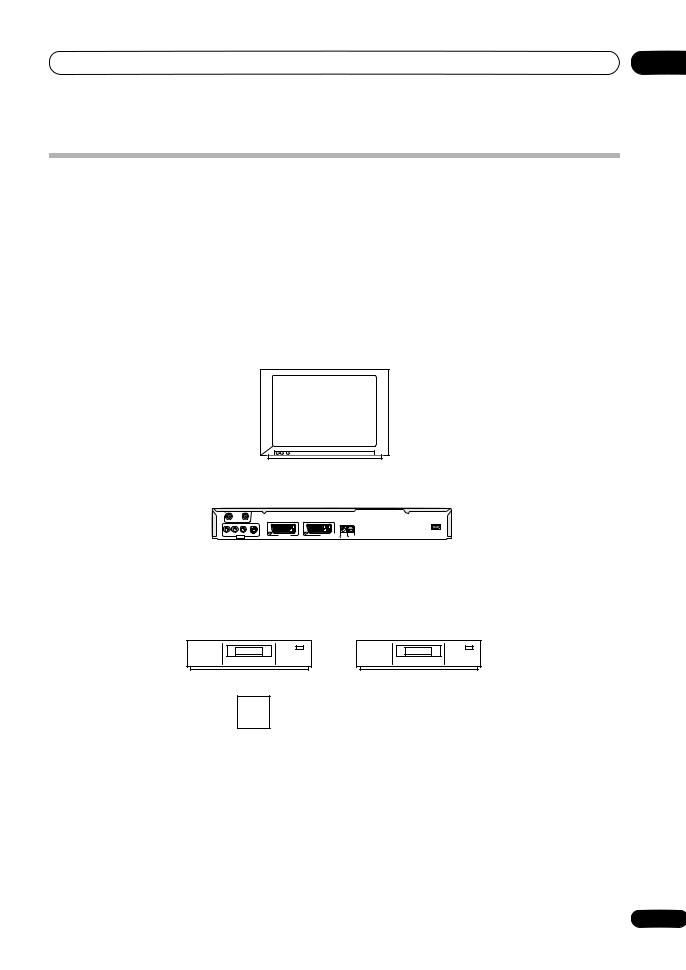
Connecting up |
02 |
Connecting an external decoder box (1)
If you have an external, dedicated decoder box for your satellite or cable TV system, use the setup described on this page.
 Important
Important
•Do not connect your decoder box directly to this recorder.
•Information from the decoder (for example, relating to pay TV services), is only viewable when this recorder is off (in standby).
•For timer recording to work properly on this recorder, the VCR/satellite receiver/cable box must also be switched on during recording.
•It is not possible to watch one TV program and record another using this setup.
SCART AV |
|
CONNECTOR |
|
4 |
TV |
ANTENNA |
|
|
|
|
|
|
OUT |
IN |
|
|
|
|
AC IN |
R |
L |
|
|
|
|
|
AUDIO |
VIDEO |
S-VIDEO |
AV 1 (RGB) - TV |
AV 2/AUTO START REC |
IN |
OPTICAL |
|
OUTPUT |
|
|
(INPUT 1/DECODER) |
CONTROL |
DIGITAL OUT |
|
3 |
|
|
2 |
|
SCART AV |
SCART AV |
|
CONNECTOR |
CONNECTOR |
|
Decoder |
VCR/Satellite receiver |
ANTENNA |
|
/Cable box |
|
|
IN |
|
|
|
 1
1
Antenna/cable TV wall outlet
1Connect the cable from the antenna/cable TV outlet to the antenna input on your VCR/satellite receiver/cable box.
2Use a SCART cable (not supplied) to connect your decoder to your VCR/satellite receiver/cable box.
See the manual for your decoder box for more detailed instructions.
3Use a SCART cable to connect your VCR/satellite receiver/cable box to the AV2/AUTO START REC (INPUT 1/DECODER) AV connector on this recorder.
4Use a SCART cable to connect the AV1(RGB)-TV AV connector to your TV.
17
En
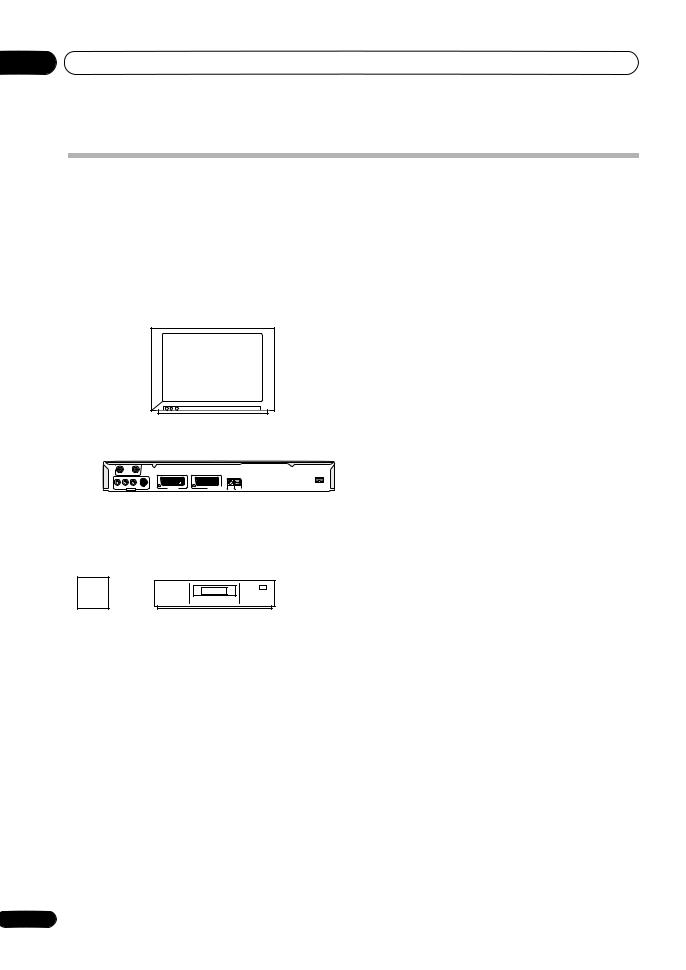
02 Connecting up
Connecting an external decoder box (2)
If you only have a decoder, connect it to this recorder and your TV as shown on this page.
Using the setup on this page you can:
• Record scrambled channels received using the recorder’s built-in TV tuner.
 Important
Important
•Do not connect this recorder ‘through’ your VCR, satellite receiver or cable box. Always connect each component directly to your TV or AV amplifier/receiver.
1 Connect RF antenna cables as shown.
|
|
ANTENNA |
|
|
|
IN |
|
1 |
2 |
SCART AV |
TV |
|
|
CONNECTOR |
|
This enables you to watch and record TV channels.
2Use a SCART cable (not supplied) to connect the AV1(RGB)-TV AV connector to a SCART AV connector on your TV.
This enables you to watch discs.
3Use another SCART cable to connect the AV2/ AUTO START REC (INPUT 1/DECODER) AV connector to a SCART AV connector on your decoder box.
This enables you to record scrambled TV channels.
ANTENNA
OUT |
IN |
|
|
|
|
AC IN |
R |
L |
|
|
|
|
|
AUDIO |
VIDEO |
S-VIDEO |
AV 1 (RGB) - TV |
AV 2/AUTO START REC |
IN |
OPTICAL |
|
OUTPUT |
|
|
(INPUT 1/DECODER) |
CONTROL |
DIGITAL OUT |
3
1
SCART AV
CONNECTOR
 Note
Note
•In order to use this setup, you will need to make the following settings from the Initial Setup menu:
–Set the AV2/L1 In setting to Decoder from the Initial Setup menu (see AV2/L1 In on page 102).
–From the Manual CH Setting screen, set the Decoder setting for the scrambled channels to On (see Manual CH Setting on page 100).
Antenna/cable TV |
Decoder |
wall outlet |
|
18
En
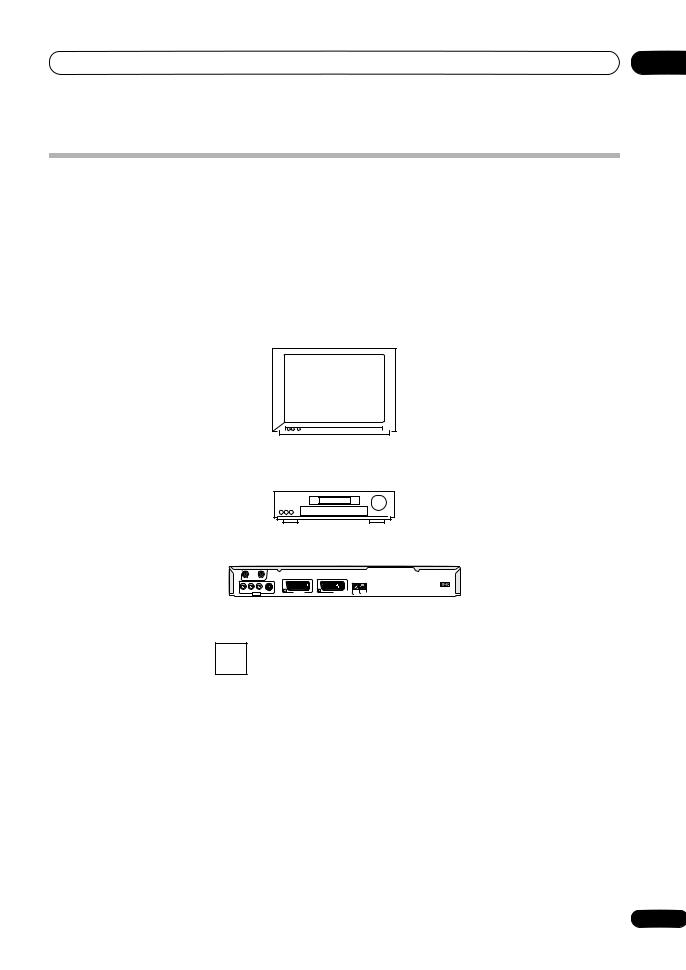
Connecting up |
02 |
Connecting to an AV amplifier/receiver
To enjoy multichannel surround sound you need to connect this recorder to an AV amplifier/receiver using the digital optical output.
In addition to a digital connection, we recommend also connecting using the stereo analog connection for compatibility with all discs and sources.
You’ll probably also want to connect a video output to your AV amplifier/receiver. Use the ordinary video output (as shown here), or the S-video output.
 Important
Important
•Noise may be output from your speakers if the recorder is not set up to work with your AV amplifier/receiver properly (see Audio Out settings on page 104).
|
ANTENNA |
|
VIDEO |
|
IN |
|
IN |
|
TV |
|
|
1 |
|
|
4 |
|
VIDEO |
|
|
|
A/V |
|
|
|
IN 1 |
OUT |
DIGITAL IN |
|
|
|
OPTICAL |
3 |
AV amp/ |
|
2 |
receiver |
|
|
ANTENNA
OUT |
IN |
R L
AUDIO |
VIDEO |
S-VIDEO |
AV 1 (RGB) - TV |
|
|||
|
OUTPUT |
|
|
1
Antenna/cable TV wall outlet
1 Connect RF antenna cables as shown.
This enables you to watch and record TV channels.
2Connect one of the DIGITAL OUT OPTICAL jack on this recorder to an optical digital input on your AV amplifier/receiver.
This enables you to listen to multichannel surround sound.
3Connect the analog AUDIO OUTPUT and VIDEO OUTPUT jacks on this recorder to an analog audio and video input on your AV amplifier/receiver.
4Connect the AV amplifier/receiver’s video output to a video input on your TV.
AC IN
AV 2/AUTO START REC |
IN |
OPTICAL |
(INPUT 1/DECODER) |
CONTROL |
DIGITAL OUT |
 Note
Note
•The diagram shows ordinary video connections, but you can alternatively use an AV connector or S-video connections, if they’re available.
 Important
Important
•Do not connect this recorder to your TV ‘through’ your VCR using A/V cables. Always connect it directly to your TV.
19
En
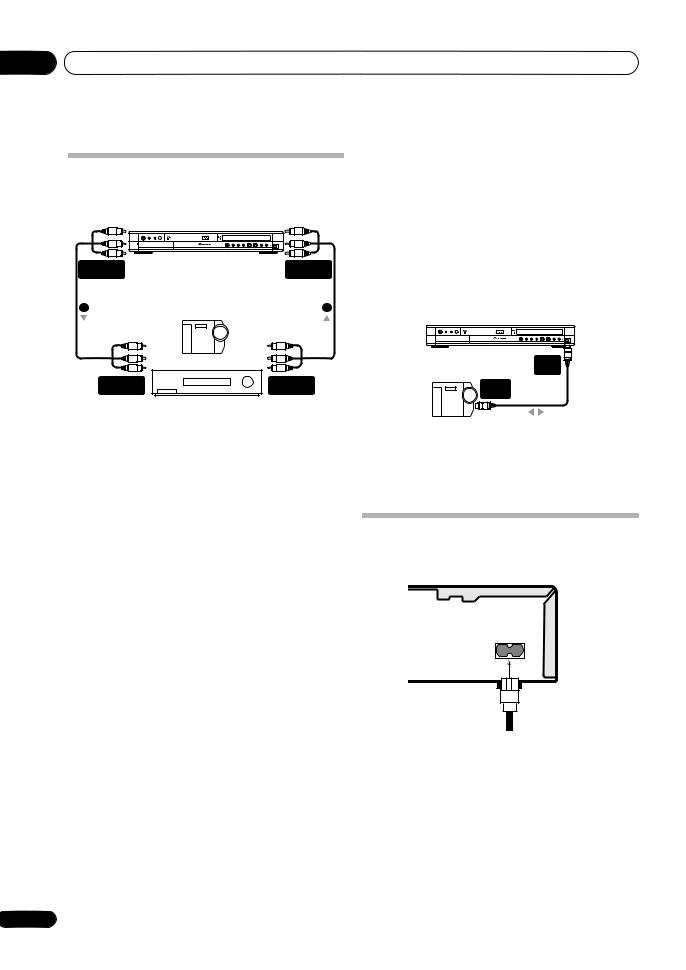
02 Connecting up
Connecting other AV sources
Connecting a VCR or analog camcorder
AUDIO/VIDEO |
AUDIO/VIDEO |
OUTPUT |
INPUT |
1 |
2 |
|
Analog camcorder |
AUDIO/VIDEO |
AUDIO/VIDEO |
INPUT |
OUTPUT |
|
VCR |
1Connect a set of audio and video outputs on your VCR or camcorder to a set of inputs on this recorder.
This enables you to record tapes from your VCR or camcorder.
•You can use ordinary video or S-video cables for the video connection.
•The front panel connections make convenient connections for a camcorder.
2Connect a set of audio and video inputs on your VCR or camcorder to a set of outputs on this recorder.
This enables you to record from this recorder to your VCR or camcorder.
•You can use ordinary video or S-video cables for the video connection.
•Alternatively, you can use the AV2/AUTO START REC (INPUT 1/DECODER) SCART connector for audio/video input and output with just one SCART cable.
20
Connecting a DV camcorder (DVR-520H/720H only)
Using the front panel DV IN/OUT jack, it is possible to connect a DV camcorder or video deck, or DVD-R/RW recorder and digitally transfer DV tapes or DVD-R/RW discs to DVD-R/RW.
 Important
Important
•This jack is for connection to DV equipment only. It is not compatible with digital satellite tuners or D-VHS video decks.
DV
IN/OUT
DV
IN/OUT
DV camcorder
1 Use a DV cable (not supplied) to connect the DV in/out jack on your DV camcorder/deck to the front panel DV IN/OUT jack of this recorder.
Plugging in
Before plugging in for the first time, make sure that everything is connected properly.
AC IN
1 Plug the supplied AC power cable into the AC IN inlet and the other end into a standard household power outlet.
En
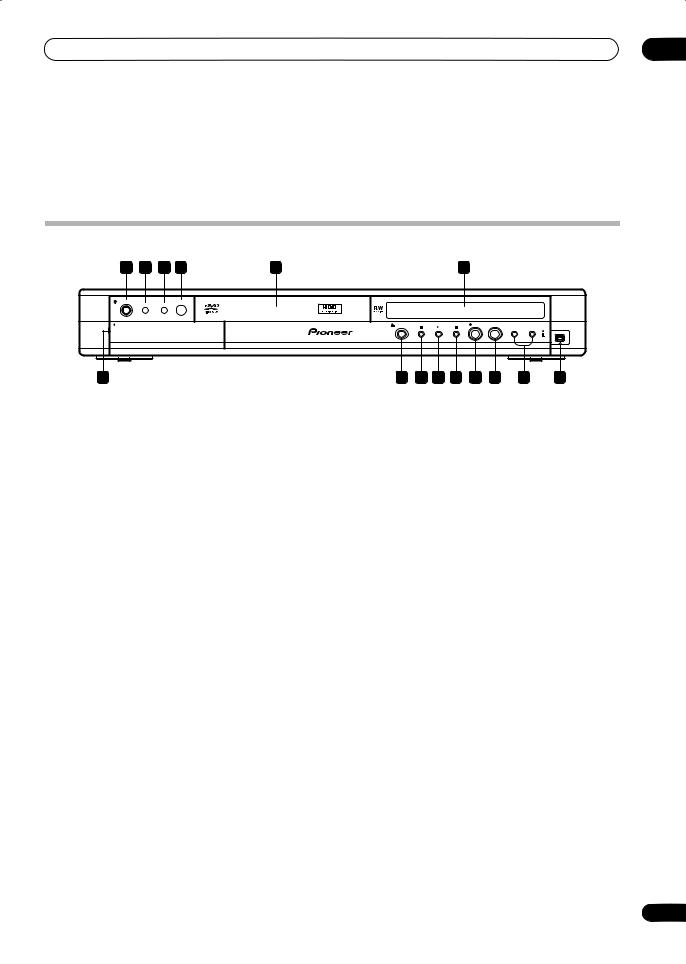
Controls and displays |
03 |
Chapter 3
Controls and displays
Front panel
1 |
2 |
3 |
4 |
5 |
6 |
STANDBY/ON |
DVD |
|
|
|
|
|
|
|
HDD |
|
|
|
|
|
|
|
|
PULL-OPEN |
OPEN/CLOSE |
|
|
|
REC |
ONE TOUCH COPY |
|
|
|
|
|
|
|
|
|
|
DV IN/OUT |
15 |
14 |
13 |
12 |
11 |
10 |
9 |
8 |
7 |
Illustration shows DVR-520H
1 STANDBY/ON
Press to switch the recorder on/into standby.
2 HDD
Press to switch to the hard disk drive (HDD) for recording and playback. The button lights when HDD is selected.
3 DVD
Press to switch to DVD for recording and playback. The button lights when DVD is selected.
4IR remote sensor (page 8)
5Disc tray
6Front panel display
See Display on page 22 for details.
7DV IN/OUT jack (DVR-520H/720H only) (page 12, 20, 56, 57, 59, 104, 117)
Digital input/output jack for use with a DV camcorder.
8+/– (page 29, 31, 48)
Use to change TV channels, skip chapters/tracks, etc.
9 ONE TOUCH COPY (page 62)
Press to start One Touch Copy of the currently playing title to DVD or the HDD.
10 REC
Press to start recording.
11
Press to stop recording.
12
Press to start or restart playback.
13
Press to stop playback.
14 OPEN/CLOSE
Press to open/close the disc tray.
15 Front panel inputs (page 12)
Pull the cover down where indicated to access the front panel input jacks. Especially convenient for connecting camcorders and other portable equipment.
21
En
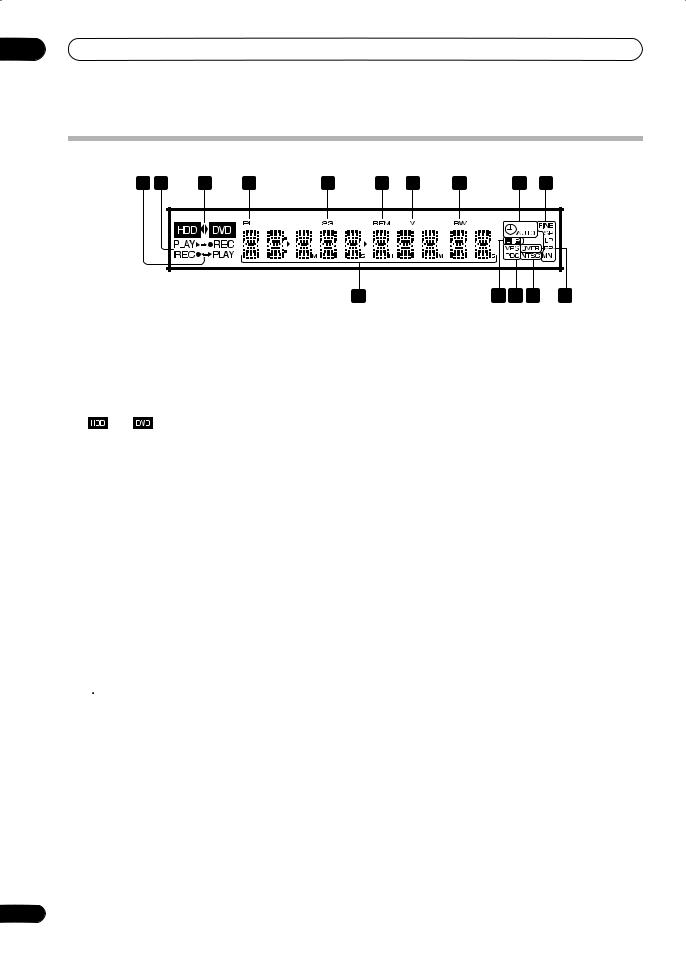
03 Controls and displays
Display
1 |
2 |
3 |
4 |
5 |
6 |
7 |
8 |
9 |
10 |
|
|
|
|
|
11 |
|
|
12 13 14 |
15 |
1 /
Arrows indicate the copy direction between the HDD (  ) and DVD (
) and DVD (  ).
).
2 PLAY / REC indicators
Lights during playback / recording; blinks when playback / recording is paused.
3 |
(page 28) |
The ‘ ’ and ‘ |
’ indicators light to indicate that the HDD |
or DVD is selected for recording/playback.
4 PL (page 78, 84)
Lights when a VR mode disc is loaded and the recorder is in Play List mode.
5 2 3 (page 99)
Shows the remote control mode (if nothing is displayed, the remote control mode is 1).
6 REM
Lights when the character display is showing the remaining available recording time.
7 V
Lights when an unfinalized Video mode disc is loaded.
8 R / RW
Indicates the type of recordable DVD loaded: DVD-R or DVD-RW.
9 (page 49)
(page 49)
Lights when a timer recording has been set. (Indicator blinks if the timer has been set to DVD but there isn’t a recordable disc loaded, or the timer has been set to HDD but the HDD is not recordable.)
AUTO (page 56)
Lights when Auto Start Recording has been set, and during Auto Start Recording.
10Recording quality indicators (page 46)
FINE
Lights when the recording mode is set to FINE (best quality).
SP
Lights when the recording mode is set to SP (standard play).
LP
Lights when the recording mode is set to LP (long play).
EP
Lights when the recording mode is set to EP (extended play).
MN
Lights when the recording mode is set to MN (manual recording level) mode.
11Character display
12
 (page 104)
(page 104)
Indicates which channels of a bilingual broadcast are recorded.
13VPS / PDC (page 49)
Lights when receiving a VPS/PDC broadcast during a VPS/PDC-enabled timer recording.
14NTSC
Lights when playing NTSC format video.
15OVER (page 104)
Lights when the analog audio input level is too high.
22
En
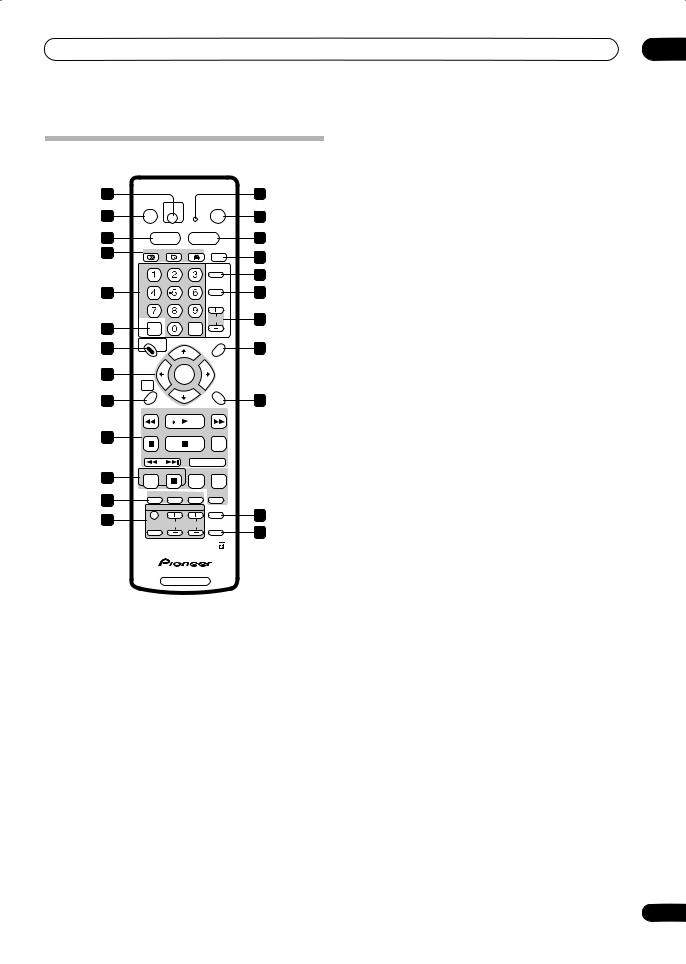
Controls and displays |
03 |
Remote control
1 |
|
|
|
|
2 |
|
STANDBY/ON |
ONE TOUCH |
|
OPEN/CLOSE |
|
3 |
|
COPY |
|
|
4 |
|
|
|
|
||
5 |
HDD |
DVD |
6 |
||
7 |
AUDIO |
SUBTITLE |
ANGLE |
PLAY MODE |
8 |
|
|
ABC |
DEF |
|
|
|
|
TV/DVD |
|
||
|
|
|
|
9 |
|
|
|
|
|
INPUT |
|
|
GHI |
JKL |
MNO |
|
|
|
SELECT |
11 |
|||
10 |
|
|
|
||
|
|
|
|
||
|
PQRS |
TUV |
WXYZ |
|
|
|
+ |
CLEAR |
CHANNEL |
12 |
|
13 |
VIDEO Plus+ |
|
|
||
|
|
CLEAR |
|
|
|
14 |
DISC NAVIGATOR |
|
PLAY LIST |
15 |
|
|
|
|
|
||
|
TOP MENU |
|
|
MENU |
|
16 |
|
ENTER |
|
|
|
|
HOME |
|
|
|
|
|
MENU |
|
|
RETURN |
|
17 |
|
|
|
|
18 |
|
REV SCAN |
PLAY |
|
FWD SCAN |
|
19 |
PAUSE |
STOP |
OK |
CM SKIP |
|
|
|
|
|
|
|
|
CASE |
|
STEP/SLOW |
|
|
|
PREV SELECTION NEXT |
|
|||
20 |
REC |
STOPREC REC MODE |
TIMER REC |
|
|
|
|
|
|
|
|
|
DISC |
NAVI |
CHP |
EASY |
|
21 |
HISTORY |
MARK |
MARK |
TIMER |
|
|
TV CONTROL |
|
|
|
|
|
|
|
DISPLAY |
22 |
|
|
|
|
|
||
23 |
INPUT |
|
|
TV DIRECT |
|
CHANNEL |
VOLUME |
|
|||
|
SELECT |
|
|
REC |
24 |
|
|
|
|
|
|
DVD RECORDER
1 ONE TOUCH COPY (page 62)
Press to start One Touch Copy of the currently playing title to DVD or the HDD.
2 Remote control indicator
Lights when setting up the remote control for use with a TV (page 112) and when setting the remote control mode (page 99).
3 STANDBY/ON
Press to switch the recorder on/into standby.
4 OPEN/CLOSE
Press to open/close the disc tray.
5 HDD (page 28)
Press to select the hard disk (HDD) for recording or playback.
6 DVD (page 28)
Press to select the DVD for recording or playback.
7DVD playback functions
AUDIO  (page 29, 43, 44)
(page 29, 43, 44)
Changes the audio language or channel. (When the recorder is stopped, press to change the tuner audio.)
SUBTITLE  (page 43) Displays/changes the subtitles included in multilingual DVD-Video discs.
(page 43) Displays/changes the subtitles included in multilingual DVD-Video discs.
ANGLE  (page 44)
(page 44)
Switches camera angles on discs with multi-angle scenes.
8PLAY MODE (page 40)
Press to display the Play Mode menu (for features such as search, repeat and program play).
9 TV/DVD (page 29)
Press to switch between ‘TV mode’, in which you get the picture and sound from the TV’s tuner, and ‘DVD mode’, in which you get picture and sound from the recorder’s tuner (or an external input).
10 Alphanumeric buttons and CLEAR
Use the number buttons for track/chapter/title selection; channel selection, and so on. The same buttons can also be used to enter names for titles, discs and so on.
Use CLEAR to clear an entry and start again.
11 INPUT SELECT (page 56)
Press to change the input to use for recording.
12 CHANNEL +/– (page 29)
Press to change the channel of the built-in TV tuner.
13 VIDEO Plus+ (page 52)
Press, then use the number buttons to enter a PlusCode® programming number for timer recording.
14DISC NAVIGATOR (page 36, 76) / TOP MENU
(page 31)
Press to display the Disc Navigator screen, or the top menu if a DVD-Video disc is loaded.
15PLAY LIST (page 78, 84) / MENU (page 31)
Press to switch between Original and Play List content on VR mode discs, or display the disc menu if a DVD-Video disc is loaded.
16 / / / (cursor buttons) and ENTER
Used to navigate all on-screen displays. Press ENTER to select the currently highlighted option.
17 HOME MENU (page 33)
Press to display the Home Menu, from which you can navigate all the functions of the recorder.
18 RETURN
Press to go back one level in the on-screen menu or display.
23
En

03 Controls and displays
19 Playback controls (page 30) |
|
REV SCAN / FWD SCAN |
(page 38) |
Press to start reverse or forward scanning. Press again to change the speed.
PLAY
Press to start playback.
PAUSE
Press to pause playback or recording.
STOP
Press to stop playback.
CM BACK (commercial back)
Press repeatedly to skip progressively backward through the audio or video playing.
CM SKIP (commercial skip)
Press repeatedly to skip progressively forward through the audio or video playing.
PREV / NEXT
Press to skip to the previous or next title/chapter/ track/folder; or to display the previous or next menu page.
STEP/SLOW (page 39)
During playback, press to start slow-motion playback; while paused, press to show the previous or next video frame.
20 Recording controls (page 28)
REC
Press to start recording. Press repeatedly to set the recording time in blocks of 30 mins.
STOP REC
Press to stop recording.
REC MODE (page 47)
Press repeatedly to change the recording mode (picture quality).
TIMER REC (page 51)
Press to set a timer recording from the standard Timer Recording screen.
EASY TIMER (page 50)
Press to set a timer recording from the Easy Timer Recording screen.
21DISC HISTORY (page 89)
Press to display summary information (disc name, recording time left, etc.) from the last 30 recordable discs loaded.
NAVI MARK (page 37)
Press to select a thumbnail picture for the current title for use in the Disc Navigator screen.
CHP MARK (page 81)
Press to insert a chapter marker when playing/ recording a VR mode DVD-RW disc or the HDD.
22DISPLAY (page 33)
Displays/changes the on-screen information displays.
23 TV CONTROL (page 112)
After setting up, use these controls to control your TV.
24 TV DIRECT REC (page 48)
Press to start recording whatever channel your TV is set to.
24
En
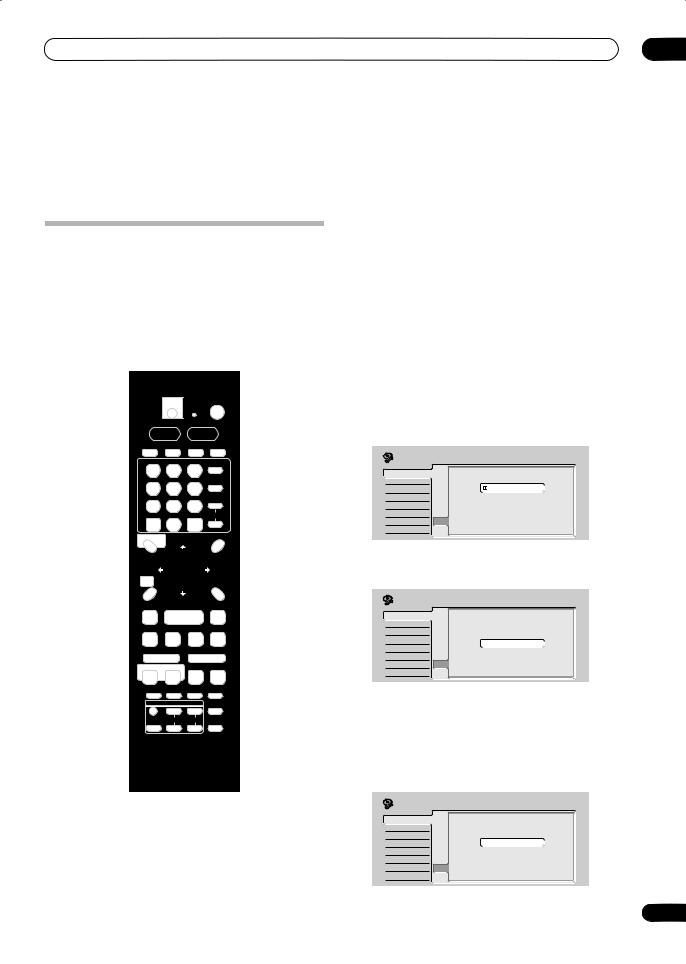
Getting started
Chapter 4
Getting started
Switching on and setting up
When you switch the recorder on for the first time, you can make several basic settings using the Setup Navigator feature. This takes you through setting the clock, the internal TV tuner and the video and audio output settings.
If you’re using the recorder for the first time, we strongly recommend you use the Setup Navigator before starting to use the recorder.
STANDBY/ON
ENTER
DVD RECORDER
04
1 Switch on your TV and set the video input to this recorder.
2 Press the STANDBY/ON button on the remote control or the front panel to switch on.
When you switch on for the first time, your TV should display the Setup Navigator screen. (If the Setup Navigator doesn’t appear, you can also access it from the Initial Setup menu; see page 99).
•If this recorder is connected to a compatible TV using a fully-wired 21-pin SCART cable, the recorder will take a few seconds to download country, TV screen size and language information. (Check the manual that came with your TV for compatibility information.)
3 Use the /(cursor up/down) buttons to choose a language, then press ENTER.
Initial Setup |
|
|
Basic |
Clock SetLanguage |
|
Tuner |
Input Line System |
English |
Video In/Out |
On Screen Display |
|
Audio In |
Front Panel Display français |
|
Audio Out |
Power Save |
Deutsch |
Language |
Remote Control SetItaliano |
|
Recording |
Setup Navigator |
Español |
Playback
4 Press ENTER to start setting up using the Setup Navigator.
Initial Setup |
|
Basic |
Clock Set Complete this setup before you |
Tuner |
Input Line System |
Video In/Out |
start using your recorder. |
On Screen Display |
|
Audio In |
Front Panel Display Start |
Audio Out |
Power Save |
Language |
Remote Control SetCancel |
Recording |
Please use the Initial Setup if you |
Setup Navigator |
|
Playback |
want to make more detailed settings. |
|
•If you don’t want to use the Setup Navigator, press (cursor down) to select Cancel, then press ENTER to exit the Setup Navigator.
5 Select the Auto Channel Setting (‘Auto Scan’ or ‘Download from TV’), or ‘Do not set’, then press ENTER.
Initial Setup |
|
|
Basic |
Auto Channel Setting |
|
Clock Set |
|
|
Tuner |
Input Line System |
|
Video In/Out |
On Screen Display |
|
Audio In |
Front Panel Display Auto Scan |
|
Audio Out |
Power Save |
Download from TV |
Language |
Remote Control Set Do not set |
|
Recording |
Setup Navigator |
|
Playback
25
En
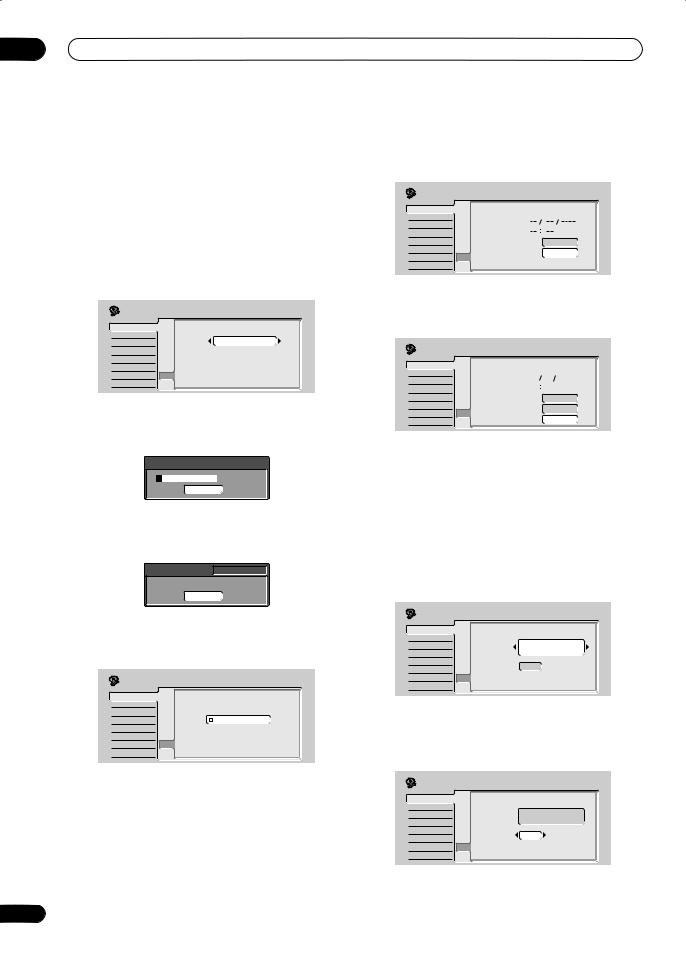
04 Getting started
•Select Do not set if you want to skip setting up the channels (because they have already been set up, for example).
•You can only use the Download from TV feature if you connected this recorder to your TV using a fully-wired 21-pin SCART cable connected to the AV1(RGB)-TV connector, and if your TV supports this function (check your TV’s instruction manual for more details).
•Use the / (cursor left/right) buttons to choose your country, then press ENTER.
Initial Setup |
|
|
Basic |
Clock SetCountry Selection |
|
Tuner |
Input Line System |
UK |
Video In/Out |
Country |
|
On Screen Display |
|
|
Audio In |
Front Panel Display |
|
Audio Out |
Power Save |
|
Language |
Remote Control Set |
|
Recording |
Setup Navigator |
|
Playback |
|
|
•Auto-tuning channels
The Auto Scan option automatically scans and sets the channel presets.
Tuning
11/107
Cancel
•Downloading channels from your TV
Use the Download from TV option to download all the channels that your TV is tuned to.
Downloading |
Pr 5 |
|
Cancel |
6 Select ‘Auto’ for automatic time setting, or ‘Manual’ to set the clock manually, then press ENTER.
Initial Setup |
|
|
Basic |
Clock SetClock Setting |
|
Tuner |
Input Line System |
|
Video In/Out |
On Screen Display |
|
Audio In |
Front Panel Display Auto |
|
Audio Out |
Power Save |
Manual |
Language |
Remote Control Set |
|
Recording |
Setup Navigator |
|
Playback |
|
|
•Auto clock setting
Some TV channels broadcast time signals together with the program. This recorder can use these signals to set the clock automatically.
Set ‘Clock Set CH‘ to the channel preset number that broadcasts a time signal, then move the cursor down to ‘Start’ and press ENTER.
Initial Setup |
|
|
|
Basic |
Clock SetAuto Clock Setting |
|
|
Tuner |
Input Line System |
|
|
Video In/Out |
Date |
|
|
On Screen Display |
|
||
Audio In |
Front PanelTimeDisplay |
|
|
Audio Out |
Power Save |
Pr 1 |
|
|
Clock Set CH |
||
Language |
Remote Control Set |
Start |
|
Recording |
Setup Navigator |
||
|
|||
Playback |
|
|
The recorder takes a short while to set the time. After you see that the time has been set, select Next to proceed.
Initial Setup |
|
|
|
|
Basic |
Clock SetAuto Clock Setting |
|
|
|
Tuner |
Input Line System |
THU |
01 |
01 2004 |
Video In/Out |
Date |
|||
On Screen Display |
|
11 |
20 |
|
Audio In |
Front PanelTimeDisplay |
|
||
Audio Out |
Power Save |
|
|
Pr 1 |
|
Clock Set CH |
|
|
|
Language |
Remote Control Set |
|
|
Start |
Recording |
Setup Navigator |
|
|
|
|
|
Next |
||
Playback |
|
|
|
|
If the time could not be set automatically, press RETURN to go back to the previous screen and select
Manual.
•Manual clock setting
If no stations in your area are broadcasting time signals, you can set the clock manually.
Use the / (cursor left/right) buttons to set your time zone.
You can set this by selecting a city or a time relative to GMT.
Initial Setup |
|
|
|
Basic |
Clock SetManual Clock Setting |
1/2 |
|
Tuner |
Input Line System |
|
England |
Video In/Out |
On Screen Display |
|
|
Audio In |
Time Zone |
|
London |
Front Panel Display |
|
||
|
|
||
Audio Out |
Power Save |
Off |
|
Language |
Summer Time |
|
|
Remote Control Set |
|
|
|
Recording |
Setup Navigator |
|
|
Playback |
|
|
|
Press (cursor down) then use the / (cursor left/right) buttons to select ‘On’ or ‘Off’ for summer time, then press ENTER.
Select On if you are currently using summer time.
Initial Setup |
|
|
|
Basic |
Clock SetManual Clock Setting |
1/2 |
|
Tuner |
Input Line System |
|
England |
Video In/Out |
On Screen Display |
|
|
Audio In |
Time Zone |
|
London |
Front Panel Display |
|
||
|
|
||
Audio Out |
Power Save |
On |
|
Language |
Summer Time |
|
|
Remote Control Set |
|
|
|
Recording |
Setup Navigator |
|
|
Playback |
|
|
|
26
En
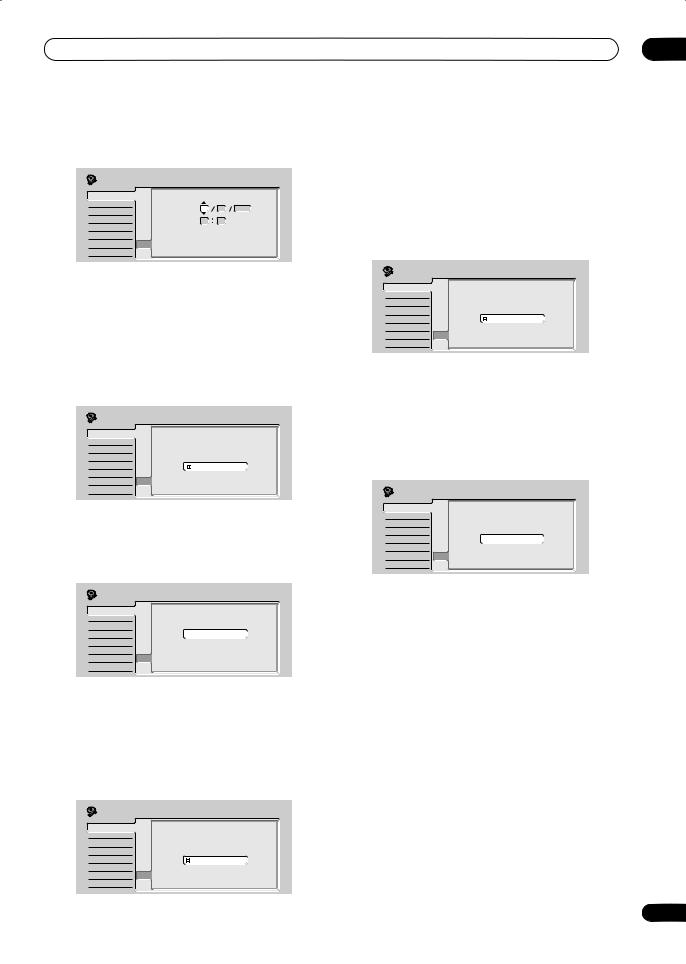
Getting started |
04 |
Set the date (day/month/year) and time, then press ENTER to make all the settings.
Initial Setup |
|
|
|
|
|
Basic |
Clock SetManual Clock Setting |
|
2/2 |
||
Tuner |
Input Line System |
THU |
01 |
01 |
2004 |
Video In/Out |
Date |
||||
On Screen Display |
|
|
|
||
Audio In |
Front PanTimel Display |
00 |
00 |
|
|
Audio Out |
Power Save |
|
England |
|
|
Language |
Time Zone |
|
|
||
Remote Control Set |
London |
|
|
||
Recording |
Setup Navigator |
|
|
|
|
|
On |
|
|
||
Playback |
Summer Time |
|
|
||
Use the / (cursor up/down) buttons to change the value in the highlighted field.
Use the / (cursor left/right) buttons to move from one field to another.
•You can go back to the previous screen at anytime in the Setup Navigator by pressing RETURN.
7 Select the TV screen type, ‘Standard (4:3)’ or ‘Wide (16:9)’.
Initial Setup |
|
|
Basic |
Clock SetTV Screen Size |
|
Tuner |
Input Line System |
|
Video In/Out |
On Screen Display |
|
Audio In |
Front Panel Display Wide (16:9) |
|
Audio Out |
Power Save |
Standard (4:3) |
Language |
Remote Control SetSetup Navigator |
|
Recording |
Setup Navigator |
|
Playback |
|
|
Use the / (cursor up/down) buttons to select, then press ENTER.
8 Is this recorder connected to an AV amplifier/ receiver for digital audio?
Initial Setup |
|
|
Basic |
Clock SetAV Amp Digital Connect |
|
Tuner |
Input Line System |
|
Video In/Out |
On Screen Display |
|
Audio In |
Front Panel Display Connected |
|
Audio Out |
Power Save |
Not Connected |
Language |
Remote Control Set |
|
Recording |
Setup Navigator |
|
Playback |
|
|
Use the / (cursor up/down) buttons to select
Connected, or Not Connected, then press ENTER.
•If you select Not Connected, that completes the setup. Press ENTER to exit the Setup Navigator, or select Go Back if you want to go back and start again.
•Select the digital audio formats your AV amplifier/ receiver is compatible with.
Initial Setup |
|
|
Basic |
Clock SetAV Amp Compatibility |
|
Tuner |
Input Line System |
|
Video In/Out |
On Screen Display |
|
Audio In |
Front Panel Display Dolby Digital |
|
Audio Out |
Power Save |
Dolby Digital,DTS |
Language |
Remote Control SetPCM only |
|
Recording |
Setup Navigator |
|
Playback
Use the / (cursor up/down) buttons to select Dolby Digital, Dolby Digital, DTS or PCM only, then press ENTER.
•Check the operating instructions that came with your AV amplifier/receiver if you’re not sure what it’s compatible with.
9 Is your AV amplifier/receiver compatible with 96 kHz PCM digital audio?
Initial Setup |
|
|
Basic |
Clock Set96kHz PCM Compatible |
|
Tuner |
Input Line System |
|
Video In/Out |
On Screen Display |
|
Audio In |
Front Panel Display Compatible |
|
Audio Out |
Power Save |
Not Compatible |
Language |
Remote Control Set Don't Know |
|
Recording |
Setup Navigator |
|
Playback |
|
|
Use the / (cursor up/down) buttons to select
Compatible, Not Compatible, or Don’t Know, then press ENTER.
•Check the operating instructions that came with your AV amplifier/receiver if you’re not sure.
10 Press ENTER to exit the Setup Navigator, or select ‘Go Back’ if you want to start again.
Initial Setup |
|
|
Basic |
Clock Set |
|
Tuner |
Input Line System |
|
Video In/Out |
Setup is complete! |
|
On Screen Display |
|
|
Audio In |
Enjoy using your DVD recorder! |
|
Front Panel Display |
Finish Setup |
|
Audio Out |
Power Save |
|
Language |
Remote Control SetGo Back |
|
Recording |
Setup Navigator |
|
Playback |
|
|
That completes basic setup using the Setup Navigator.
Other settings you can make
After setting up using the Setup Navigator, you should be ready to start enjoying your DVD recorder. It’s possible, however, that you may want to make a couple of additional settings, depending on how the recorder is set up for terrestrial TV broadcasts.
•Manual channel setting – This setting lets you skip channels where there is no station, as well as manually tune to stations. See Manual CH Setting on page 100.
•VIDEO Plus+ channel setting – This setting lets you assign guide channels to ensure that the VIDEO Plus+ programming system works correctly. See Set VIDEO Plus+ CH on page 101.
•Setting up the remote to control your TV – You can set up the supplied remote control to control many brands of TV. See Setting up the remote to control your TV on page 112.
27
En
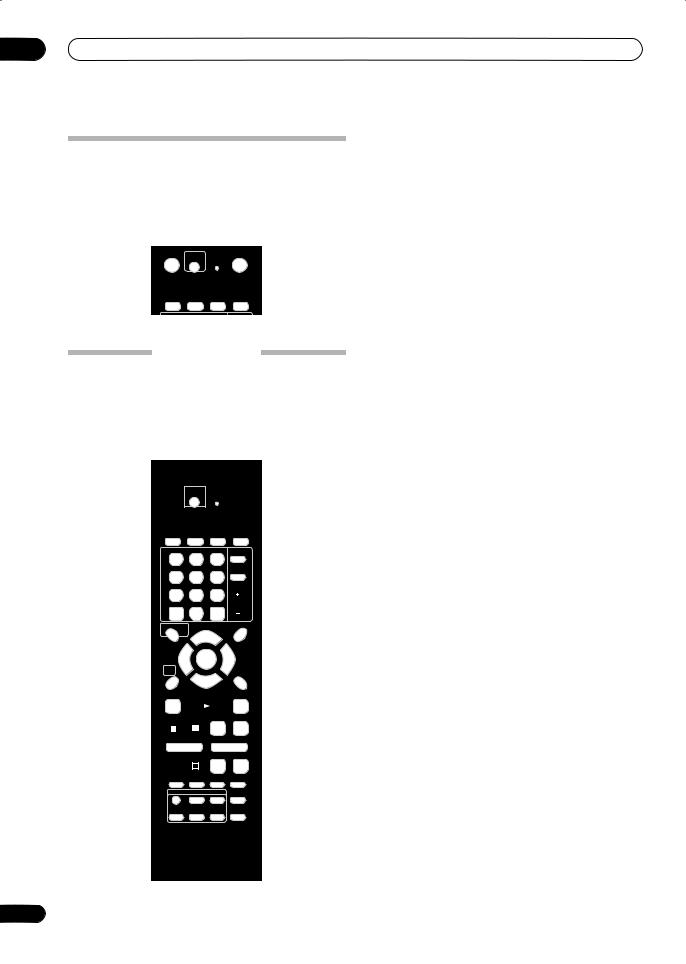
04 Getting started
Selecting the hard disk or DVD for playback and recording
The HDD and DVD buttons (remote control and front panel) are used to select the hard disk (HDD) or DVD for playback and recording. The indicator in the front panel display shows which is currently selected.
HDD DVD
Making your first recording
This quick guide shows you how to make a basic recording of a TV program on either the HDD, or to a recordable DVD.
Recording is covered in much more detail in chapter 6 (Recording).
STANDBY/ON |
OPEN/CLOSE |
HDD DVD
CHANNEL
PLAY
STOP
REC STOPREC
DVD RECORDER
28
1If they aren’t already on, switch on your TV and this recorder.
Press STANDBY/ON to switch on.
•Make sure that the video input on your TV is set to this recorder.
2Press HDD to record to the HDD, or DVD to record to a recordable DVD.
If you choose to record to the HDD, skip to step 5 now.
3 Press OPEN/CLOSE to open the disc tray.
4Load a blank DVD-R or DVD-RW disc with the label side face-up, using the disc guide to align the disc.
•When you load a new, blank DVD-RW disc, the recorder will take a moment to initialize it for recording.
5Use the CHANNEL +/– buttons to select the TV channel you want to record from.
•You can also use the +/– buttons on the front panel if the recorder is stopped.
•Channel presets are numbered 1–99.
•If the recorder is connected to your TV using a SCART cable and your TV supports Direct Recording, it’s possible to quickly start recording whatever channel your TV is tuned to. See Direct recording from TV on page 48 for detailed instructions.
6 Press REC to start recording.
•By default, the recording will be in SP (standard play) mode, which will give you around two hours of recording from a blank DVD disc.
• You can pause recording by pressing PAUSE. Press REC or PAUSE again to restart recording.
7 When you want to stop recording, press STOP REC.
Playing back your recording
The TV program you just recorded should be on the HDD or DVD disc as a single title with one or more chapters.
• Press PLAY to start playback.
If you want to stop playback before the end of the recording, press STOP.
En
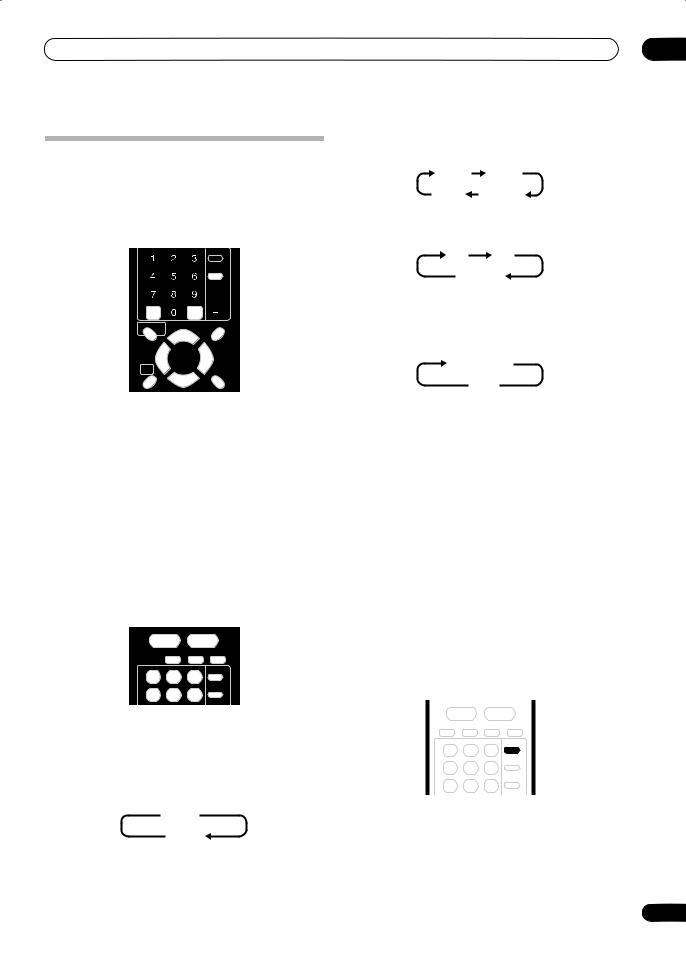
Getting started
Using the built-in TV tuner
Changing TV channels
There are three different ways to select TV channels. Note that you can’t change the TV channel during playback, recording or during recording standby.
CHANNEL
ENTER
•CHANNEL +/– buttons on the remote
•Number buttons on the remote – For example, to select channel 4, press 4 then ENTER; for channel 34, press 3, 4, ENTER.
•+/– buttons on the front panel
 Note
Note
•Channel presets are numbered 1–99.
•You can’t change TV channels during playback or recording, or while in recording standby.
Changing audio channels
You can change the audio channel of the broadcast or external input signal.
AUDIO
•Press AUDIO to change the audio.
The current audio channel is displayed on-screen.
•If the NICAM audio setting (see NICAM Select on page 103) is set to NICAM and you are watching a NICAM broadcast, you can switch between NICAM and Regular (non-NICAM) audio.
 NICAM
NICAM
Regular
04
•If the NICAM broadcast is bilingual, you can also select the language.
NICAM A |
NICAM B |
Regular |
NICAM A+B |
•You can also select the language for a non-NICAM bilingual broadcast.
A (L) |
B (R) |
A + B (L+R)
•When watching a recording made from an external input with Bilingual recording selected (see External Audio on page 103), you can switch the audio channel between left (L), right (R) or both (L+R).
L  R
R
L+R 
 Note
Note
•When recording to the HDD, or in Video mode, or in VR mode using the FINE/MN32 setting, only one channel of a bilingual broadcast is recorded. In this case, decide which language you want to record before recording by setting the Bilingual Recording setting (see Bilingual Recording on page 104).
Switching between TV and DVD
When the recorder is stopped or recording you can choose whether to have the audio/video from the built-in TV tuner (or external input) play on your TV (‘DVD mode’), or watch the channel that the TV is currently set to (‘TV mode’).
During playback or when a menu is being displayed onscreen, the sound and video is always routed to your TV and is unaffected by the TV/DVD mode setting.
Note that the recorder must be connected to your TV using a SCART cable to be able to use this feature.
TV/DVD
• Press TV/DVD to switch between TV mode and DVD mode.
29
En

04 Getting started
Basic playback
This section shows you how to use your recorder for playback of discs (DVD, CD, etc.), and for playback of video from the HDD. More playback features, such as repeat and program play, are covered in the next chapter.
 Important
Important
•Throughout this manual, the term ‘DVD’ means playback-only DVD-Video discs and DVD-R/RW. If a function is specific to a particular kind of DVD disc, it is specified.
•Some DVD-Video discs don’t allow certain playback controls to operate at certain points in the disc. This is not a malfunction.
STANDBY/ON |
OPEN/CLOSE |
ENTER
PLAY
STOP
DVD RECORDER
1 Press STANDBY/ON to switch on.
Also turn on your TV and make sure that it is set to the correct video input.
2 Press HDD to playback from the HDD, or DVD to play a DVD.
If playing video from the HDD, skip to step 5 below.
30
3 Press OPEN/CLOSE to open the disc tray.
4 Load a disc.
Load a disc with the label side facing up, using the disc tray guide to align the disc (if you’re loading a doublesided DVD-Video disc, load it with the side you want to play face down).
•If you want to play a DTS audio CD, please first read the note on page 32.
5 Press PLAY to start playback.
•If you’re playing a DVD-Video or Video CD, a disc
menu may appear when you start playback. Use the / / / (cursor) buttons and ENTER to navigate DVD disc menus, and the number buttons and ENTER for Video CD menus.
•When playing video from the HDD, playback will automatically stop after the end of a title is reached.
•See the following sections for more details on playing specific kinds of discs.
6 To stop playback, press STOP.
7 When you’ve finished using the recorder, eject the disc and switch the recorder back into standby.
• To open/close the disc tray, press OPEN/CLOSE. Remove the disc before putting the recorder into standby.
•Press STANDBY/ON to switch the recorder into standby.
En
